Reserve Bank Bulletin – May 2001 Statement on Monetary Policy
Download the complete Statement 781KB
The international environment facing the Australian economy has deteriorated considerably this year. Most of this reassessment occurred in the March quarter, when estimates of global growth were marked down and further sharp falls in share prices occurred. More recently, there have been some signs, at least in financial markets, of greater confidence in the economic outlook re-emerging, no doubt helped by the substantial monetary easing that has taken place in the United States and other English-speaking economies. Nonetheless considerable uncertainty remains.
The US economy and financial markets have been central to the reassessment of the global outlook that has occurred. US growth slowed quickly and unexpectedly in the December quarter last year, and for a time during the March quarter many forecasters were pointing to the possibility of a contraction in GDP in that quarter. In the event, the outcome was better than expected, with the data recording growth in the quarter, albeit at a fairly modest pace.
The path ahead for the US will depend on how much of last year's inventory build-up has still to be corrected, and whether there is a continuing impact from the share market weakness: broadly-based measures of US share prices remain about 20 per cent below last year's peaks, even after the sizeable recent recovery. The extent of the unfolding decline in investment in information technology, from the very high levels reached in 2000, is also a factor which will be important for the US outlook.
Significantly for Australia, Asia has been one of the regions most affected by the slowing of US demand, particularly for technology products. The economies in east Asia slowed abruptly late in 2000 and in early 2001, after a period of strong growth, as the boom in world demand for information-technology products ended. In addition, the largest economy in the region – Japan – continues to suffer from continuing domestic problems such as impaired balance sheets, weak asset prices, and deflation in prices for goods and services. The low level of the Australian dollar is helping to cushion the impact of this international deterioration on the domestic economy, but it is unlikely that Australia will be unaffected by the sort of slowing that has occurred in world growth.
The Australian economy slowed quite sharply in the second half of 2000 and conditions remained weak in the early months of 2001. A moderation in growth had long been anticipated, but it was expected to be relatively mild. Why then was the outcome so much weaker than expected? The answer lies mostly in the exceptionally large decline in dwelling investment, which was a result of the transitional effects of introducing the GST. A slowdown has also clearly occurred in many other areas of the economy. But the housing downswing, which was larger and faster than expected, accounts for most of the difference between the mild overall slowdown in growth which was anticipated and the small net contraction in output which the national accounts recorded over the second half of last year.
Of itself, the housing sector weakness was always likely to be a temporary factor, and there are signs that the housing sector is beginning to recover. But the weakness in housing construction flowed on to affect some other parts of the economy, noticeably the manufacturing sector. The greater-than-expected decline in overall growth, both internationally and at home, also had a significant impact on consumer and business confidence. Measures of business sentiment had already weakened late in 2000, but declined further in the March quarter. Consumer confidence declined sharply after the publication of the December quarter GDP result (which was affected by the above one-off factors) and remained low thereafter. Confidence was also affected by the decline in the exchange rate at that time, which reached a new low against the US dollar.
The labour market has reflected the above developments. Particularly notable has been the fall in employment in construction, which accounted for all of the net decline in employment between August and February. Employment in the rest of the economy fell for a few months but then began to grow again, though at a reduced pace from that seen in early 2000. The decline in job vacancies among skilled occupations also has been heavily concentrated in the construction and related sectors. Overall, the unemployment rate has moved up, and could rise somewhat further as the labour market will lag any strengthening in economic growth.
Inflation in Australia remains well-contained, despite the fall in the exchange rate. The latest CPI data showed a rise of 6 per cent for the year to March. Of this, around 3 percentage points is likely to be the effect of the GST and other tax measures, with a further contribution from the rise in petrol prices. Measures of underlying inflation, with allowance for GST effects, are around 2½ per cent.
This assessment of underlying inflation is higher than the figure of around 2 per cent the Bank offered, based on the December quarter data, in the previous Statement. The December quarter data were unexpectedly low, given the extent of cost increases observed over the preceding year, and suggested some squeeze on firms' profit margins. The Bank's judgement is that the most recent result is likely to reflect the partial unwinding of that squeeze, including the passing through of some exchange rate effects. Given the subdued state of domestic demand growth at present, a continuation of this process appears to be manageable without a significant deterioration in medium-term inflation performance. Growth of labour costs has picked up slightly over the past year, as would be anticipated after a lengthy period of labour market strength, but the softer labour market conditions now being observed should cap this trend in due course. Overall, the Bank expects that inflation will remain within the 2–3 per cent target zone in the period ahead.
Between early February and early April, the Bank eased monetary policy three times, taking cash rates almost to their previous cyclical low points. The pace of easing exceeded that at which interest rates rose last year, and was also faster than the previous period of monetary policy easing in 1996–98.
The reason for this rapid action by the Bank was the speed of the change in both international and domestic circumstances during the first few months of the year. Some moderation in global growth had been expected, but the speed and extent to which the slowing emerged were a surprise. At the same time, the unexpected weakness of the housing sector, its effects on manufacturing and the deterioration in business and consumer confidence became clearer. The possible effects on spending of this decline in confidence posed the risk of more persistent weakness in demand even after the housing downswing finished.
Given that inflation remained well-controlled, this combination of risks to the outlook for economic activity meant that there was a prima facie case for an easing of monetary policy, to return policy to a clearly expansionary setting. The confidence that the community and financial markets have that inflation will be kept low, moreover, also meant that there was ample scope for easing to proceed relatively quickly.
As a result of this sequence of interest rate reductions, financial conditions have become quite accommodative. In real terms, interest rates are low relative to historical experience. The level of the real exchange rate, although rising over the past month, is also around its historical low, and the growth of credit is strong. Under most circumstances, these conditions would be expected to facilitate a pick-up in growth. Capital market developments over recent weeks have been suggestive of improved confidence: share markets in Australia, which declined much less than overseas markets earlier in the year, have returned to peak levels; credit spreads on corporate bonds are falling; and the extreme uncertainty that drove government bond yields down seems to have abated. There are also early signs that lower interest rates, together with recent Government initiatives, are starting to produce a turnaround in the housing market.
With these encouraging signs, and with a significant easing in monetary policy having occurred since the beginning of February, the Bank stayed its hand at its May meeting. Whether such promising trends will continue, turning into a sustained strengthening of growth, remains unclear at present, partly because the course of events will be influenced strongly by overseas developments, about which there is still a good deal of uncertainty. The Bank will continue to monitor all the relevant information and respond if appropriate.
International Economic Developments
United States
The slower growth in the second half of 2000 has continued into 2001. Real GDP grew by 0.5 per cent in the March quarter and by 2.7 per cent over the year to the March quarter – less than half that recorded in the middle of last year (Graph 1). In response to the slowdown in growth, the Federal Reserve Board has reduced official interest rates by a total of 200 basis points since the beginning of the year. In its policy announcements, the Fed has expressed concern about the effect lower profitability and the decline in wealth, associated with the fall in equity markets, may have on investment and consumption.
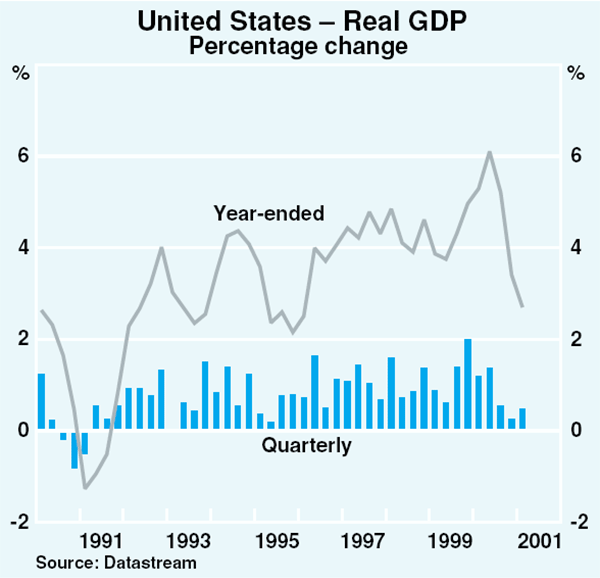
Despite the low level of consumer confidence, slower employment growth and the decline in household wealth associated with the falls in equity prices, consumption grew by 0.8 per cent in the March quarter (Graph 2), supported by continued strong growth in household borrowing. A major risk to the outlook for consumption is the prospect of households seeking to rebuild savings in response to the fall in household wealth. Partially offsetting this, the new administration has announced a range of tax incentives that should boost private demand, while lower home mortgage rates have eased the debt service burden of households. The reduction in mortgage rates over the past year has also boosted the housing sector, with investment in housing increasing by 0.8 per cent in the March quarter, after declining through the second half of 2000.
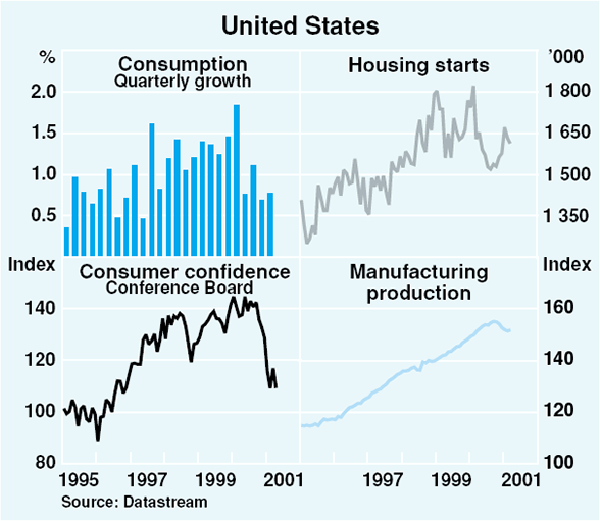
In contrast, the pace of business investment has slowed sharply in the past two quarters, particularly investment in plant and equipment, reflecting an increase in spare capacity combined with heightened concerns over the outlook for the economy. The slowdown in the business sector has been most pronounced in manufacturing, as weaker sales growth in both domestic and external markets led to an unanticipated increase in inventories and a reduction in profits. However, there are some signs that the manufacturing sector may have reached its trough. The National Association of Purchasing Managers (NAPM) survey of manufacturers has recovered a little, although it remains at low levels, and the inventory correction in some areas of manufacturing appears to have been relatively rapid. Against this, there are increasing signs that the weakness in manufacturing is spreading to other sectors, evidenced by falling profits in the latter part of 2000 and into 2001.
The labour market has thus far remained relatively resilient to the slowdown in growth, but signs of weakness are emerging. Employment growth averaged nearly 120,000 per month over the first three months of 2001, compared with an average of less than 50,000 (adjusted for census and striking workers) in the December quarter 2000. Employment did, however, decline in the month of March, as falls in employment in the retail and wholesale trade and some services sectors added to the existing weakness in employment in the manufacturing sector. The unemployment rate has increased gradually over the past six months to 4.3 per cent, compared with the low of 3.9 per cent recorded last October, and jobless claims are around their highest level in nearly a decade.
Wages growth has remained steady at a little over 4 per cent (Graph 3). Consumer price inflation has declined from its recent highs although core inflation has edged higher to be 2.7 per cent over the year to March 2001, compared with 2 per cent in early 2000. The price of services continues to increase at a strong rate but goods prices fell in March.
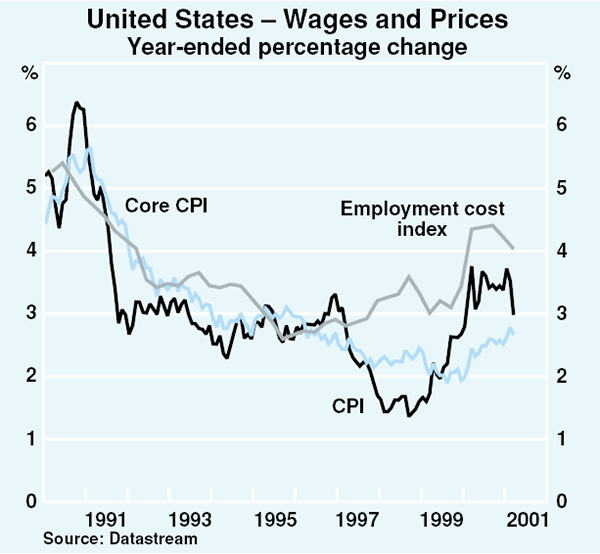
Japan
Growth in the Japanese economy also slowed in the second half of 2000 (Table 1), and the near-term outlook for Japan appears rather poor. The Ministry of Economy, Trade and Industry's overall business activity index suggests that activity has remained broadly flat in recent months (Graph 4). Further, the Bank of Japan's Tankan survey recorded a deterioration in business sentiment in the March quarter – the first since December 1998. This decline largely reflected concerns about external demand conditions – export volumes in March 2001 were around 5 per cent below their peak in August 2000. Over the same period, industrial production declined by 6 per cent while machinery orders were 16 per cent lower. These factors have caused businesses to scale back their capital expenditure intentions for the year ahead.
| Six months to: | ||
|---|---|---|
| June 2000 | December 2000 | |
| Private consumption | 2.3 | −0.6 |
| Government consumption | 0.7 | 0.5 |
| Business fixed investment | −0.2 | 2.5 |
| Residential investment | −0.1 | 0.4 |
| Public investment | 1.1 | −1.6 |
| Change in stocks | 0.4 | 0.0 |
| Net exports | 1.1 | −0.9 |
| – Exports | 1.8 | 0.2 |
| – Imports | −0.7 | −1.1 |
| GDP | 5.4 | 0.2 |
|
Source: Datastream |
||
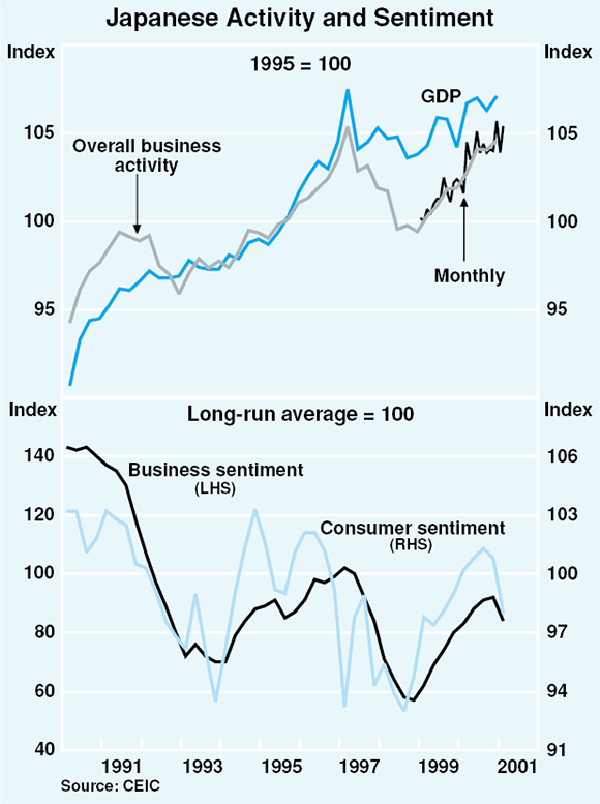
The prospects for a sustained rebound in consumption appear poor, although recent data indicate that household expenditure increased early in 2001. Job offers fell in the first three months of 2001 for the first time since mid 1999, and employment growth in recent months has weakened. Household income is growing only slowly, and consumer sentiment has declined to be below its long-run average after rising steadily through 1999 and most of 2000.
The deteriorating outlook has prompted a number of stimulatory policy initiatives from the Bank of Japan and the Government. The Bank of Japan has returned to its zero-interest-rate policy and announced that it intends to retain it until consumer prices stop falling. At present, prices are continuing to fall: excluding food, consumer prices fell by 0.6 per cent over the year to March. The Government recently announced measures to facilitate the removal of non-performing loans from domestic banks' balance sheets over the next two to three years, as well as proposals for limiting banks' corporate share holdings.
Non-Japan Asia
After growing strongly through the first three quarters of 2000, economic growth in non-Japan Asia slowed abruptly in the December quarter. The slowdown was caused by declines in both external and private domestic demand. The pace of growth has softened most noticeably in Singapore and Korea, both of which recorded declines in output in the most recent quarters (Graph 5).
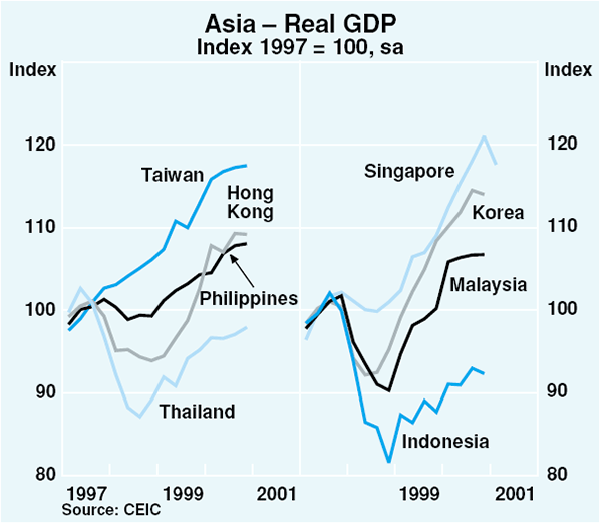
The slowdown in the US economy and the sharp decline in global demand for ITC equipment has had a marked effect on the region's exports. Exports had grown by around 15 per cent over the first three quarters of 2000 but declined by 2 per cent in the December quarter. Exports of electronic goods accounted for much of the decline, but growth in non-electronic exports also slowed noticeably. The outlook for ITC production and exports is likely to remain constrained in the near term given the decline in new orders for electronics in the US (Graph 6). The slowdown in exports has spilled over into a fall in industrial production in the region from its peak in August 2000 and contributed to the decline in business investment.
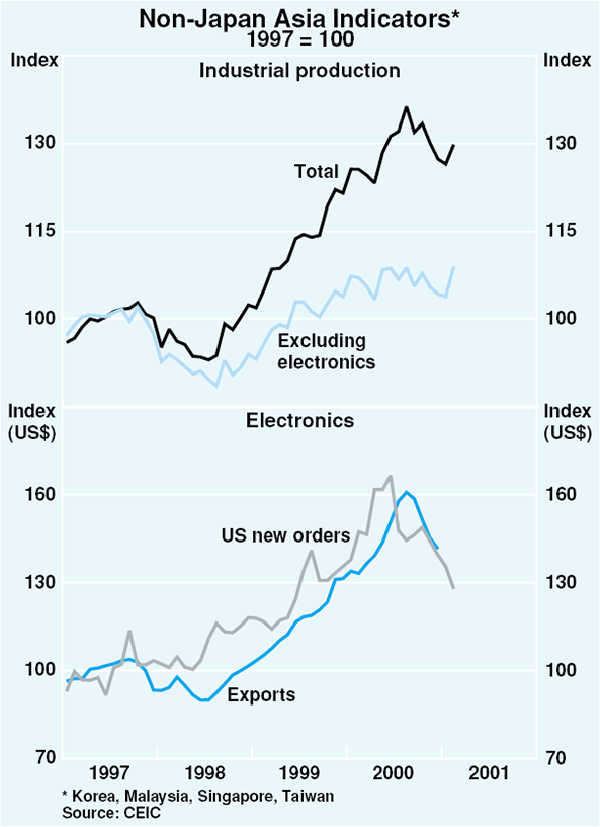
Consumption growth in the region also slowed sharply in the December quarter, in part reflecting a slowdown in employment growth and rising unemployment. The level of employment in Korea and Taiwan is little changed from a year earlier and the unemployment rates in the two countries have drifted up from their lows in the middle of 2000.
In response to the weaker outlook for the external sector and waning domestic spending, policy-makers across the region have eased macro-economic policies to support growth in the short term. In Malaysia, Singapore and Taiwan more expansionary fiscal policies have been adopted, while in Taiwan, Korea and the Philippines interest rates have been reduced to boost domestic consumption and investment.
New Zealand
The New Zealand economy grew solidly in 2000, though growth slowed towards the end of the year. Those parts of the economy most exposed to external markets performed relatively better, reflecting the effect of the exchange rate depreciation. The Reserve Bank of New Zealand (RBNZ) has reduced official interest rates by half a percentage point in the past two months to 6 per cent, citing concerns about the outlook for the world economy. Consumer price inflation remains above the RBNZ's target band, despite prices falling by 0.1 per cent in the March quarter.
Europe
Growth in the euro area slowed a little in the second half of 2000, as weaker domestic demand was only partially offset by a stronger contribution from the external sector (Graph 7). Consumer spending has picked up a little in 2001, supported by high levels of consumer confidence, tax cuts, and solid employment growth. The euro area unemployment rate has fallen to 8.4 per cent, the lowest in over ten years. In contrast, industrial production and new orders have weakened and business sentiment has continued to decline. Consumer price inflation has declined, but at 2.6 per cent in March, remained above the ECB's 2 per cent target. The core measure of inflation has gradually increased to be 1.8 per cent in March.
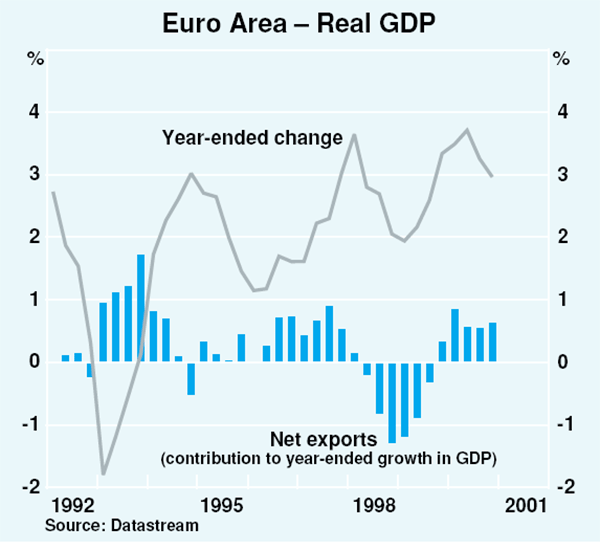
In the United Kingdom, growth was again relatively modest in the March quarter. Industrial production has fallen by 1¾ per cent from its peak in August last year, and business sentiment has declined. Strong growth in consumption has continued into 2001, underpinned by the low unemployment rate and steady growth in wages. The Bank of England cut rates by 0.25 per cent in April to 5.5 per cent, the second cut for the year, citing concerns about slowing world growth, the impact of the foot-and-mouth epidemic and recent sharp falls in share prices.
The world economic outlook
The outlook for the world economy for 2001 has been continuously downgraded over the past six months, primarily driven by increased pessimism about the outlook for the US economy and the effect that a weaker US economy is likely to have on those countries that have extensive trade linkages with it. The IMF has reduced its forecast for global growth for 2001 to 3.2 per cent from 4.2 per cent last October, a considerable slowdown from growth of 4.8 per cent recorded in 2000 (Graph 8). The average of private-sector forecasts is similar to these numbers. World growth is expected to rebound in 2002, but the recovery is highly dependent on the recovery in the US economy: the IMF is expecting growth in the US economy to pick up to 2.5 per cent in 2002 from 1.5 per cent in 2001.
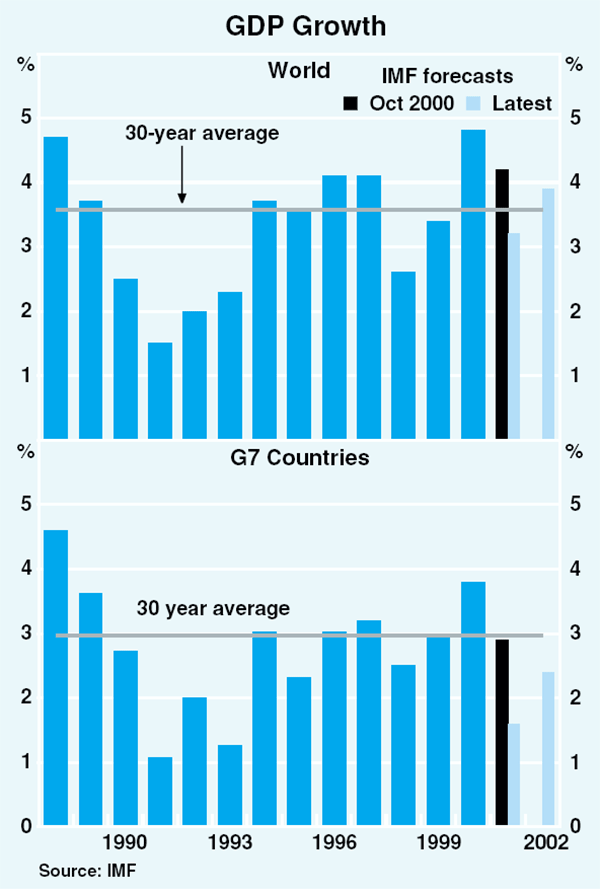
Inflation remains generally well contained in the major industrialised countries. The main source of inflationary pressure has been the rise in the price of oil, but to date, there has been relatively little spillover into other prices, and more recently this pressure has abated as oil prices have declined from their highs of mid 2000.
The benign inflation environment has enabled policy-makers to respond swiftly to the deterioration in growth prospects. While the easier fiscal and monetary policies should act to stabilise confidence in the near term and stimulate domestic demand later in the year, the IMF identifies significant downside risks. In particular, the prospects of lower world growth could expose fragilities in financial markets and intensify the downward pressures on equity markets in the US and elsewhere.
International and Foreign Exchange Markets
Short-term interest rates
The process of global monetary easing that began in the US in early January 2001 continued over the past few months. The Federal Open Market Committee has now cut the Fed funds target by a cumulative 200 basis points, to 4.5 per cent, the most aggressive start to an easing cycle in the US since the mid 1980s (Graph 9 and Table 2). Financial markets continue to price-in further interest rate reductions over coming months with trading in futures markets suggesting that the Fed funds target will fall to 4 per cent by mid year (Graph 10). This is below the previous trough of 4.75 per cent in late 1998, though not as low as in the early 1990s recession when the Fed funds rate fell to 3 per cent.
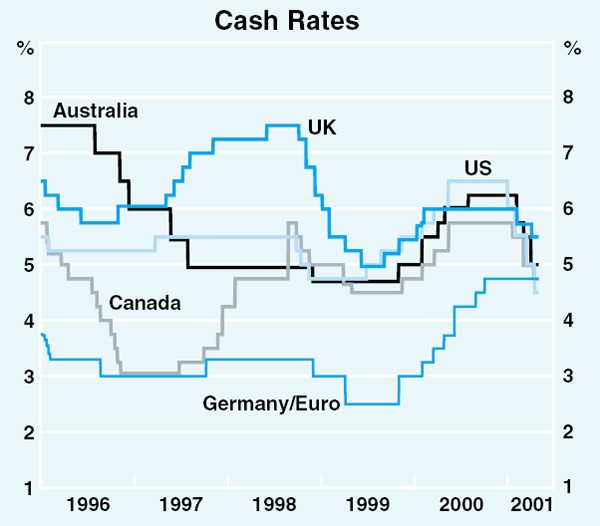
| 2001 | Cumulative decrease Since Jan 2001 |
Current level Per cent |
||||
|---|---|---|---|---|---|---|
| Jan | Feb | Mar | Apr | |||
| US | 100 | 50 | 50 | 200 | 4.50 | |
| Australia | 50 | 25 | 50 | 125 | 5.00 | |
| Canada | 25 | 50 | 25 | 100 | 4.75 | |
| NZ | 25 | 25 | 50 | 6.00 | ||
| UK | 25 | 25 | 50 | 5.50 | ||
| Japan | 10 | 15 | 25 | 0.0 | ||
| Switzerland | 25 | 25 | 3.25 | |||
| Euro area | 0 | 4.75 | ||||
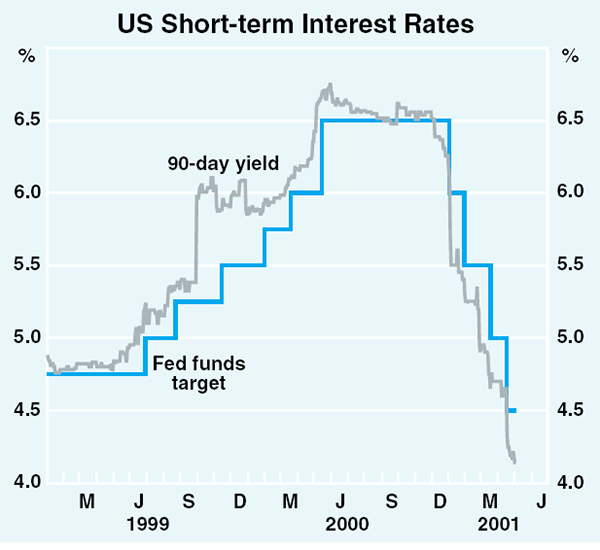
Other English-speaking countries have also eased monetary policy since the beginning of 2001, though not to the same extent as the US. Aside from the easings in Australia, which are discussed in the chapter on ‘Domestic Financial Markets’, the Bank of Canada has cut the overnight cash rate by 100 basis points to 4.75 per cent, and the Bank of England and the Reserve Bank of New Zealand have both reduced their target rate by 50 basis points to 5.50 per cent and 6.0 per cent, respectively.
The Bank of Japan (BoJ) has also eased policy, cutting the overnight call rate by 10 basis points to 0.15 per cent in late February, and then in mid March adopting a new set of operating procedures which in effect returned the overnight call rate to near zero. To complement its injection of short-term liquidity, the BoJ also announced that it will increase its outright purchases of long-term government bonds. Moreover, to bolster confidence that this policy will halt the deflationary forces in the economy, the BoJ has stated that the current policy will remain in place until underlying inflation rises to at least zero per cent on a year-ended basis.
In Europe, the Swiss National Bank eased rates by 25 points in March, to 3.25 per cent, but the European Central Bank remains the exception among the major central banks, keeping policy rates unchanged at 4.75 per cent. European policy rates are now above those in the US for the first time since late 1994.
Many Asian countries, including Korea, Taiwan, the Philippines, Hong Kong, and Malaysia have also eased monetary policy over recent months in response to some slowdown in their economies. Several other emerging market economies, however, have had to raise interest rates despite slowing output growth to counter exchange rate pressures. Included in this group are Indonesia, Turkey and Brazil.
Long-term interest rates
Over the past month or so, the fall in US bond yields that had been going on since May last year (when the Fed carried out its last monetary tightening) seems to have ended (Graph 11). Yields on 10-year US bonds last May were about 6.5 per cent, the same as the then Fed funds rate. By the start of the December quarter they had drifted down to a little under 6 per cent, but then fell sharply further as the US economic and financial situation deteriorated and investors sought safe haven in government bonds. The fall continued into the first three months of this year, with yields reaching a low of 4.75 per cent in mid March. Since then, bond yields have risen quite sharply again, back to their early January levels, as the Fed's cuts to official interest rates contributed to a general improvement in financial market sentiment, including a substantial recovery in the equity market.
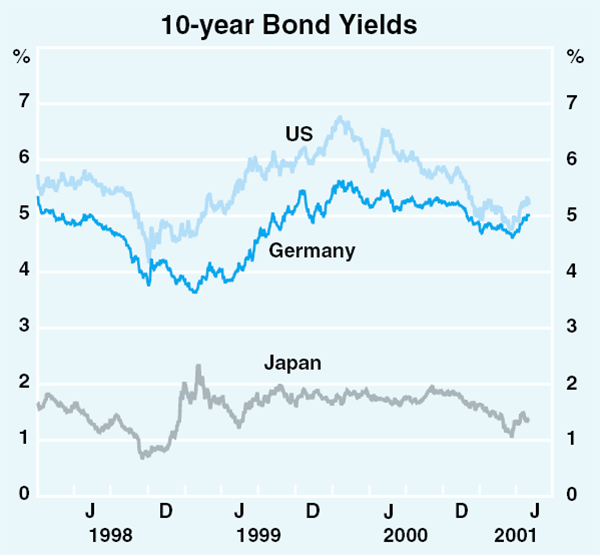
Over recent months there have been substantial changes in the slope of the yield curve in the US (Graph 12). In early January, the yield on 10-year Treasury securities was about 160 basis points below the then Fed funds target – i.e. the yield curve was inverted. The yield curve last showed such a significant inversion just before the US moved into the early-1990s recession. By early May, however, following substantial cuts in short rates and a rise in long rates, the 10-year yield was 70 basis points above the Fed funds target. This more normal relationship points to greater confidence in markets that the rapid easing by the Fed will avoid a prolonged period of weakness in the US economy.
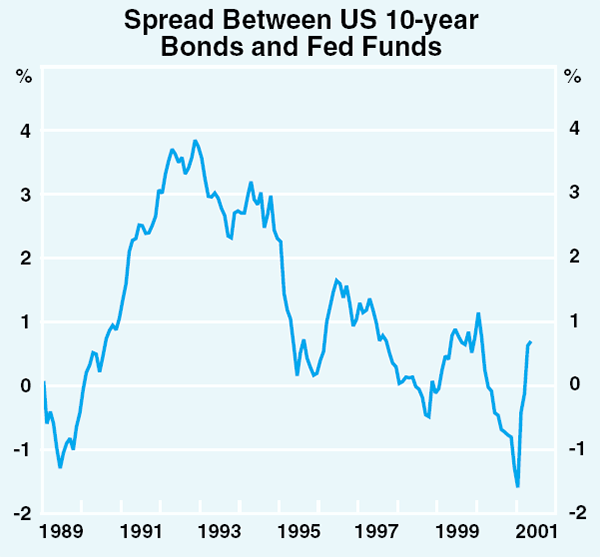
Another indication of some reduction in risk aversion in US markets is that credit spreads on non-government bonds have fallen back somewhat after rising sharply last year (Graph 13). These spreads tend to rise during periods of economic uncertainty as investors in those circumstances prefer the security of government debt. During 2000, these spreads rose to levels last seen in the early 1990s recession. They remain above average, though well down from their peaks.
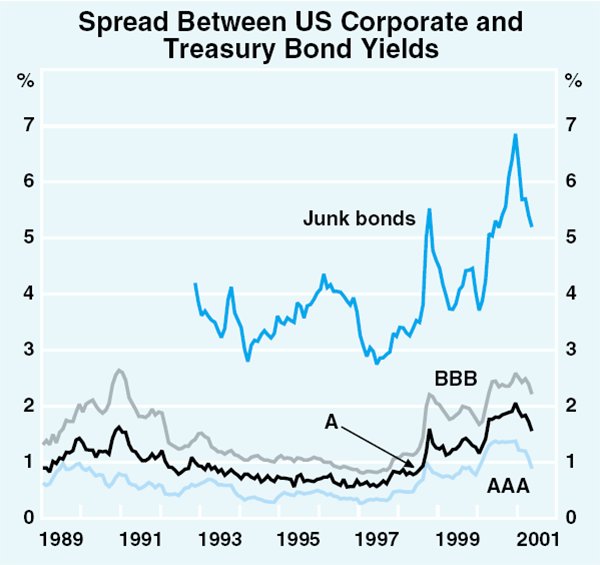
In European bond markets, yields on long-term government debt have followed a similar pattern to US yields, although the magnitude of movements has been more muted than that in the US. Yields on German 10-year government debt fell by around 25 basis points between January and mid March to 4.6 per cent. However, like US yields, they have since more than retraced these falls, moving to around 5.0 per cent. The spread between US and German 10-year government bonds narrowed to only around 5 basis points in late March, but has since moved out to around 20 basis points.
Japanese long-bond yields have broadly followed the same pattern as seen in the US and Europe over the past few months. They fell quite sharply over January, February and the first half of March, with yields on 10-year bonds reaching a low of around 1.05 per cent as the outlook for the economy deteriorated, equity prices fell and the BoJ eased monetary policy further. There has been a small rise in bond yields since then as the equity market recovered.
Among emerging bond markets, a clear distinction is evident between Latin America and Asia (Graph 14). In the former, credit spreads have risen significantly, due to concerns about the sustainability of exchange rate arrangements in Argentina and possible contagion of financial instability to neighbouring countries. Spreads in Asia, in contrast, have fallen marginally. Even though economic growth in most Asian economies is slowing, their finances, both public and external, generally remain in good shape and investors see little need to demand higher risk premia.

Equity markets
World share markets experienced large falls over February and March as uncertainty regarding the economic outlook increased and corporate earnings expectations fell. In the US, the fall was led by the technology-rich NASDAQ index, which fell 43 per cent during its February/March decline, to a level 68 percent below its peak of about a year ago (Graph 15 and Table 3). For much of 2000, share market weakness was concentrated in this sector, but in early 2001 it spread more widely. The Dow Jones industrial average (which covers largely ‘blue chip’ stocks) fell 15 per cent between January and March.
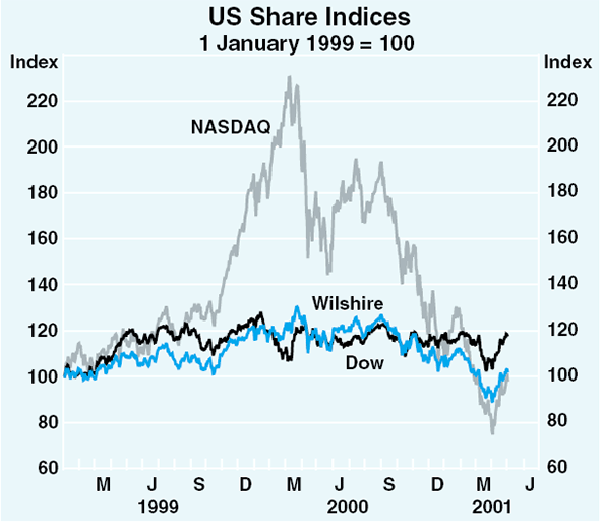
| Change since 2000 peak |
Change over 2001 |
2001 peak to trough |
2001 trough to now |
|
|---|---|---|---|---|
| United States | ||||
| – Wilshire | −22 | −5 | −21 | 14 |
| – Dow Jones | −8 | 0 | −15 | 15 |
| – S&P 500 | −18 | −5 | −20 | 13 |
| – NASDAQ | −58 | −13 | −43 | 31 |
| Germany | ||||
| – DAX | −25 | −5 | −21 | 13 |
| United Kingdom | ||||
| – FTSE | −17 | −7 | −16 | 9 |
| Japan | ||||
| – Nikkei | −31 | 5 | −16 | 22 |
| Australia | ||||
| – ASX 200 | −1 | 4 | −7 | 8 |
| Canada | ||||
| – TSE 300 | −30 | −11 | −21 | 7 |
In early April, sentiment changed as investors began to look through the current economic weakness to an expected rebound in economic growth and the associated improvement in profits. Since the early April trough, the NASDAQ has risen by around 30 per cent, while broader indices rose by about half that amount. It is too early to tell whether these recoveries, despite being substantial, will prove to be lasting. On a couple of previous occasions over the past year the fall in the NASDAQ was punctuated by significant rises, but each proved to be temporary.
One consideration is that share prices remain high relative to traditional measures of share valuation such as price-earnings ratios (Graph 16). The current P/E for the S&P 500, for example, of around 25, remains well above its historical average of 16 even though it is well down from the peak of 36 last year. Price-earnings ratios of technology stocks also remain high (over 100), as the recent large price falls have been accompanied by steep declines in earnings.
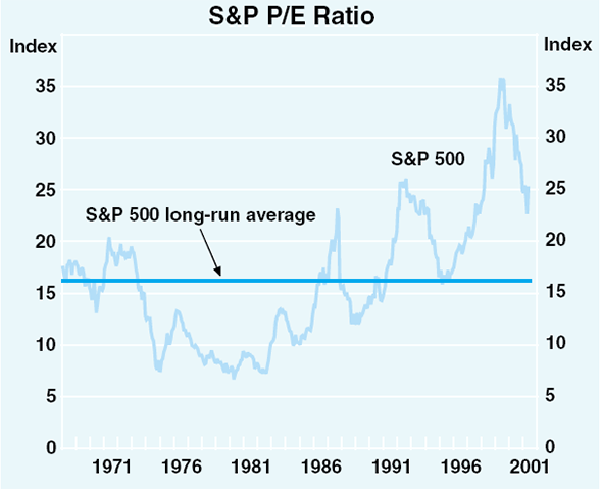
Share prices in other countries have generally taken their lead from the US. The German DAX fell around 20 per cent over February and the first half of March, but has since recovered over half that amount. The Japanese Nikkei fell 16 per cent from the beginning of the year, hitting a 16-year low of 11,820 in mid March before recovering all of this fall. Share prices in emerging markets also weakened in early 2001 but have not recovered as much as those in developed countries more recently (Graph 17).
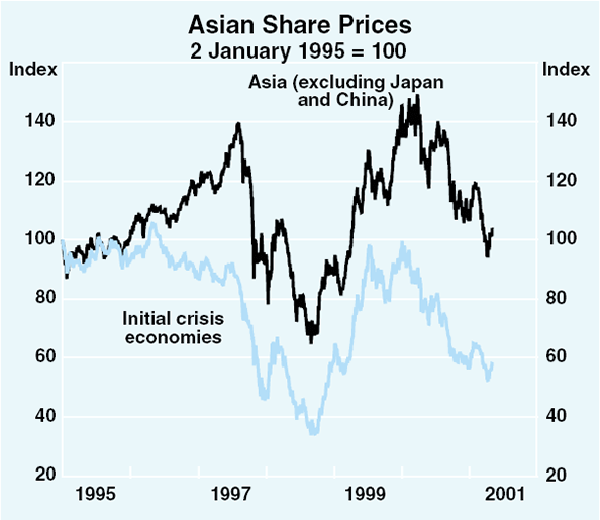
Exchange rates
The defining characteristic of international currency markets since 1997 – a strongly rising US dollar – remained in place in the early months of 2001 (Graph 18). Between the start of the year and early April it climbed a further 6 per cent on a trade-weighted basis. The rise was puzzling as the factors which had been used to explain the US dollar's strength over the previous few years had all turned around: the US economic outlook was deteriorating more rapidly than elsewhere, equity prices were falling sharply, and the extent to which interest rate differentials favoured the US was narrowing.
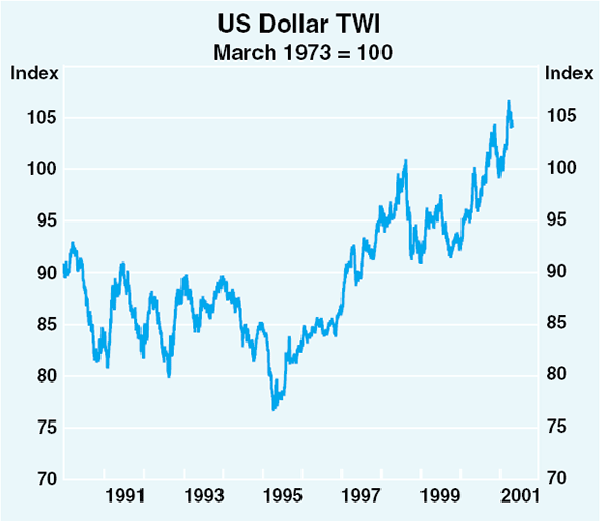
Despite this, the US dollar's appreciation was broad-based, with rises against every major currency in the world (Graph 19). This included the yen, which had managed to stay with the US dollar for much of 2000. Over the March quarter the US dollar appreciated by 7 per cent against the euro, 10 per cent against the yen, 5 per cent against sterling, 5 per cent against the Canadian dollar, 8 per cent against the Swiss franc, and 13 per cent against the Australian dollar.

More recently, however, there have been some signs of a change in sentiment in currency markets and the US dollar's upward momentum appears to have stalled. Since early April, the trade-weighted US dollar has fallen by 2 per cent. As with the earlier strength, the recent weakness has been broadly based against the major industrialised economies.
It is hard to pinpoint the reasons for this turnaround or its timing. Taking account of other market developments, such as the rise in US bond yields, the fall in credit spreads and the recovery in equity markets, it could be that the calming of financial market nervousness may have reduced the earlier safe haven demand for US dollars.
Currencies of those Asian countries with floating exchange rates have fallen significantly against the US dollar over the past year, with falls ranging from 6 per cent for the Singapore dollar to 40 per cent for the Indonesian rupiah (Graph 20). The US dollar's strength on world markets was an important factor in explaining these falls and to that extent they represented an appropriate response by floating exchange rates. Some of the larger falls also reflected domestic developments, including political uncertainty. In trade-weighted terms, the falls in these currencies have been much smaller than against the US dollar.

Australian dollar
From its local peak in early January of US57.3 cents, the Australian dollar fell to a low of US47.8 cents in early April (Graph 21). This was one of the largest percentage falls in the currency in such a short period since the mid 1980s. It sits oddly against the generally bullish predictions by market analysts at the start of the year.
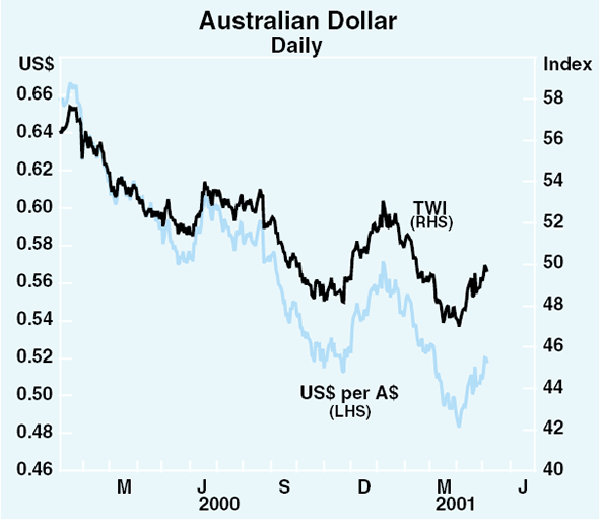
Part of the reason for this unexpected fall was the further surge in the US dollar which, as noted above, was itself a puzzling development. The Australian dollar's fall against currencies other than the US dollar was substantially smaller. The fall against the euro and the yen, for example, was only about half that against the US dollar. Mirroring this, the trade-weighted index fell significantly less than the exchange rate against the US dollar.
Aside from the role played by the strong US dollar, the reasons for this latest fall in the Australian dollar are not as yet clear. Part of the explanation may be that expectations of Australian growth were revised down sharply over these months. Up until the release of the December quarter national accounts, general expectations had been that the Australian economy would be more resilient than the US economy, as many of the sources of weakness in the US (particularly falling share prices and a very high exchange rate) were not present domestically.
The fall in output shown by the national accounts caught market participants by surprise. These data proved pivotal in changing assessments about the economy, with forecasts for activity in the year ahead revised down sharply. The consequential changes to the expectations about equity returns and interest rates were a significant negative for the exchange rate. Much of the weakness of the exchange rate occurred in the couple of weeks following that data.
Over the past month or so, the Australian dollar has staged a substantial recovery. Just as the earlier fall was to some extent a reflection of US dollar strength, the recent rise, to a degree, has been the counterpart of a fall in the US dollar in world markets. But not all the rise can be attributed to this: the Australian dollar has risen against all other major currencies, indicating independent strength. Contributing to this was some refocussing by markets away from the disappointing December quarter national accounts to the underlying strengths of the Australian economy, particularly the lack of imbalances. Also contributing was the further cut in US interest rates. It not only widened the extent to which interest rates favoured Australia but also made markets more comfortable about prospects for a recovery in US (and, therefore, world) economic activity, as evidenced by a rise in bond yields, a strong recovery in share prices and falls in credit spreads in private debt. In this environment, the Government's decision to disallow Shell's takeover of Woodside had little lasting impact.
The current level of the exchange rate against the US dollar, at around US52 cents, is still unusually low. The currency is also near its all-time lows against the yen. However, on average against the currencies of other industrial countries (the euro area, the pound, the Swiss franc, the Swedish krona and the Canadian and New Zealand dollars) it remains not much different from the rates that have prevailed for most of the post-float period (Graph 22). It is well above its average levels against currencies which maintain an adjustable peg against the US dollar, since these countries (largely those in Asia) have had a history of periodic devaluations. These patterns suggest a more encouraging assessment of the Australian dollar than would be reached simply by looking at the rate against the US dollar (or even the TWI which is heavily influenced by the US dollar rate).
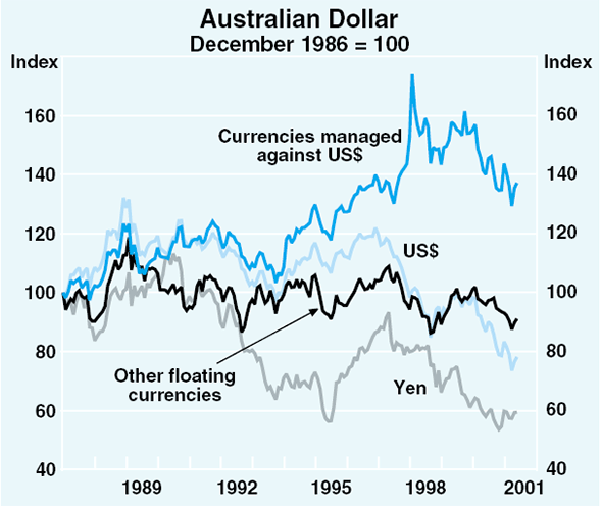
In the first four months of 2001, the RBA bought about $1 billion of Australian dollars in the market to provide a steadying influence at times when the exchange rate was under strong downward pressure. It also sold $1.4 billion of foreign exchange to the Commonwealth Government. Other transactions (including interest receipts) resulted in outright purchases of foreign exchange of $1.3 billion. The total of the above transactions was a fall of about $1.1 billion in net reserves. Valuation effects worked in the opposite direction, adding $1.0 billion, with the result that net reserves in Australian dollar terms have declined marginally in 2001, to about $8.9 billion.
The RBA has so far this year acquired $3.4 billion of foreign exchange under swap transactions undertaken for domestic liquidity management. The main purpose of these transactions was to provide Australian dollars to domestic banks to replace funds withdrawn by the Commonwealth budget surplus. In past years, this would normally have been done by buying government securities from banks, but the low supply of these now limits the amount which the RBA can acquire. It therefore supplies Australian dollars to the market on a swap basis in exchange for US dollars. Swaps outstanding now stand at $28 billion. When added to the RBA's net reserve position, this lifts gross reserves to around $37 billion, compared with $34 billion at the start of the year.
Domestic Economic Activity
The December quarter national accounts show that the Australian economy contracted slightly over the second half of 2000 following a number of years of strong growth (Graph 23). To a large extent, this result can be attributed to developments in dwelling investment, which subtracted more than 2 percentage points from GDP growth over the second half of the year after having contributed 1 percentage point to growth over the first half of the year. The surprisingly sharp swing in dwelling investment largely reflected the introduction of the new tax system in the middle of 2000, which provided an incentive to shift housing construction activity into the first half of the year. Broadly similar patterns in construction activity were evident across states, leading to a marked weakening in final demand growth in each state in the second half of 2000.
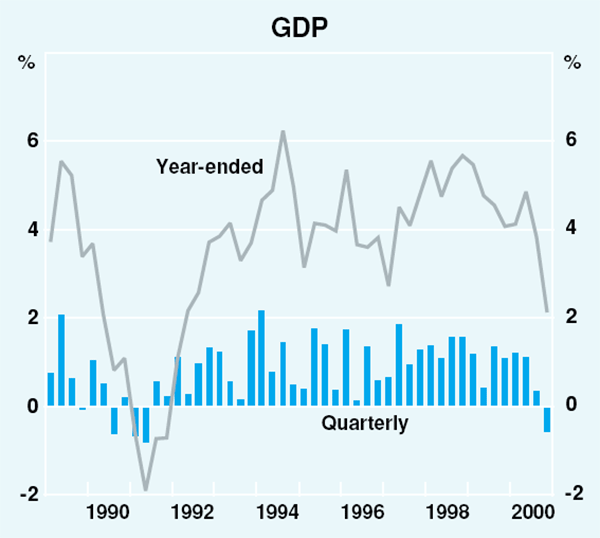
Even after abstracting from dwelling investment, however, it is clear that domestic demand slowed in the second half of 2000. This may have reflected the important linkages that the construction sector has with other parts of the economy, especially manufacturing, and other disruptions arising from the change in taxation arrangements and the Olympic Games. Rising petrol prices and increases in the interest burden of both the household and business sectors may have also been important. Together, these factors contributed to a weakening in confidence, and showed up in weaker consumer spending and some deferral of investment plans in the second half of 2000. Net exports, however, added significantly to growth during the second half of the year, as did inventory accumulation (Table 4).
| Six months to: | December quarter 2000 |
||
|---|---|---|---|
| June quarter 2000 |
December quarter 2000 |
||
| Consumption | 1.5 | 0.9 | 0.5 |
| Dwelling investment | 18.0 | −35.1 | −15.4 |
| Business investment(a) | 4.7 | −2.2 | −3.3 |
| Public final demand(a) | −1.9 | 1.4 | −1.6 |
| Change in inventories(b) | −0.4 | 0.9 | 0.8 |
| Net exports(b) | 0.1 | 0.8 | 0.2 |
| Gross domestic product | 2.3 | −0.2 | −0.6 |
| (a) Excluding transfers between the public and private sectors (b) Contribution to GDP growth |
|||
Economic conditions remained subdued through the first few months of 2001. Within the housing sector, the leading indicators suggest a pick-up in activity in coming months, although activity probably remained fairly weak through the March quarter. While retail trade picked up through the summer, consumer sentiment deteriorated sharply in March and remained low in April, implying that there is a risk of weakness in consumer spending in the period ahead. Overall, the business surveys have implied that conditions have remained weak; these have not, however, pointed to a significant deterioration in conditions from those recorded a few months ago. The level of the exchange rate is supportive of exports.
Household consumption
Consumer spending grew at a more moderate pace in 2000 relative to previous years, increasing by 2½ per cent over the year to the December quarter, compared with growth of around 5¼ per cent over the previous year. The slowing in spending was particularly noticeable on clothing and footwear, on the operation of motor vehicles, and at hotels, cafés and restaurants, and was concentrated in New South Wales and Victoria. Consistent with the relative price changes associated with the tax changes, in the second half of 2000 the share of consumer spending on goods and services whose price rose the most (such as clothing and footwear, accommodation, and café and restaurant meals) fell relative to those items experiencing falls in price (such as motor vehicles). Although the pattern of consumption has changed, in aggregate the effects of the tax changes on the timing of consumption expenditures have been small.
More recently, the value of retail sales, which accounts for about one-third of consumption expenditure, has accelerated, increasing by 3.4 per cent over the three months to February and by more than 8 per cent over the year (Graph 24). In part, this may have reflected an increase in price growth. Sales of food, recreational goods and products from department stores have increased strongly, while sales of household goods and spending on hospitality and services have been weak. This pick-up in sales has been fairly evenly spread across states, with the notable exception of Western Australia, where sales have been very weak. Sales of motor vehicles, in contrast, have fallen in the March quarter, following very strong growth during the second half of last year, and have returned to around the average level recorded during the past few years.
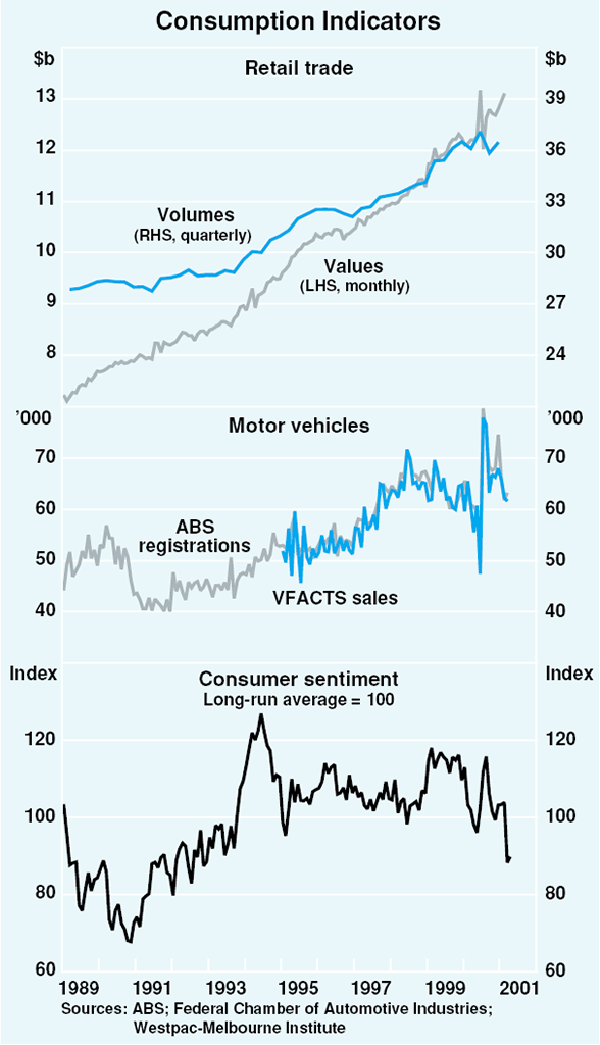
A number of factors are likely to have contributed to the slowdown in consumption growth during 2000. Increased expenditure on petrol due to higher prices probably led to a reduction in real consumer spending in other areas. Petrol prices increased by around 24 per cent over the year to the December quarter, implying that in real terms, the price of fuel faced by Australian consumers has been higher than at any time since the Gulf War. With households, on average, spending around 3 per cent of their total consumption expenditure on fuel, and having only a limited ability to substitute in the short term (for example by travelling shorter distances, taking public transport or buying more fuel-efficient cars), the rise in petrol prices could have reduced aggregate consumption over the year by up to ¾ of a percentage point, depending on the household sector's capacity to use savings to pay for the higher fuel costs.
The household interest burden also rose noticeably over 2000, from a little over 6 per cent to just under 8 per cent, its highest level since the early 1990s. This reflected increases in interest rates and continued strong growth in borrowing by households. The cumulative 125 basis point cut in official interest rates in 2001, however, implies that the household interest burden will have declined in recent months.
In previous years, strong growth in consumption had been supported by strong growth in the value of household assets, driven by both dwelling and equity price increases. During the past year, however, little increase in the value of household assets was recorded (Table 5). A deceleration in growth was evident across most asset classes, with the turnaround in the measured value of dwellings particularly pronounced. Through 2000, measures of dwelling prices were affected by compositional changes caused by the introduction of the first homebuyers' grant, but all available measures suggest a marked slowing in dwelling price growth from earlier years. Growth in the value of household financial assets also slowed, primarily reflecting slower growth in the value of equity holdings. However, growth rates remained positive, in contrast to the US where the value of household direct equity holdings fell by 25 per cent over the year to December.
| Level $b | Share of total assets per cent |
Year-ended growth (per cent) |
||
|---|---|---|---|---|
| Average 1996–99 |
December 2000 |
|||
| Non-financial assets | 1,724 | 59.3 | 14.0 | −2.4 |
| – Dwellings | 1,599 | 54.9 | 15.0 | −2.8 |
| – Consumer durables | 126 | 4.3 | 3.2 | 3.5 |
| Financial assets | 1,185 | 40.7 | 10.1 | 6.4 |
| – Currency and deposits | 256 | 8.8 | 4.5 | 6.2 |
| – Equities and unit trusts | 250 | 8.6 | 26.7 | 8.6 |
| – Superannuation and life offices | 609 | 20.9 | 10.1 | 5.4 |
| – Other | 69 | 2.4 | −5.1 | 7.1 |
| Total assets | 2,909 | 100.0 | 12.5 | 1.0 |
These dampening influences were partly offset by the boost to household income from the tax cuts and social benefit increases associated with the new tax system. Over the second half of 2000 these changes boosted disposable income by about $3.8 billion and more than offset the increase in prices over the period. However, with growth of compensation of employees slowing in line with the weakening labour market and lower profitability in the unincorporated sector, real household disposable income recorded little growth over the second half of 2000, though at year's end, income was still 3 per cent higher than a year earlier (Graph 25). The household saving ratio fell over the second half of the year, after drifting higher during the preceding couple of years. Periods of slower income growth are often associated with a fall in the household saving ratio, although to the extent that consumption has been encouraged in recent years by buoyant asset price growth, the more subdued market conditions of late may have provided households with a greater incentive to save.
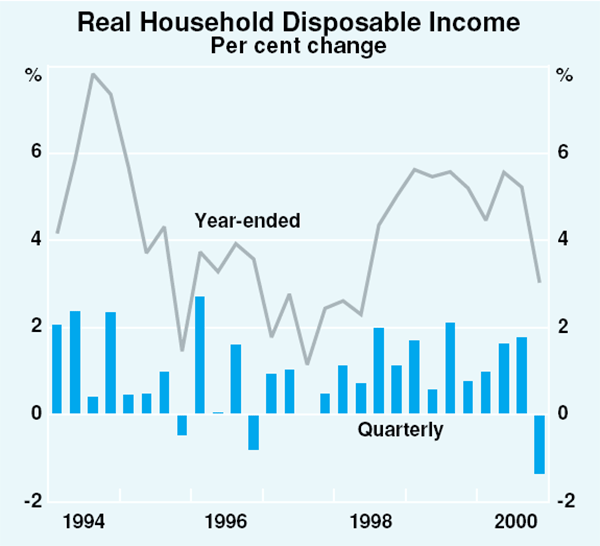
The above factors, combined with news about overall economic conditions, the exchange rate and interest rates, contributed to considerable swings in consumer sentiment over the course of the year. According to the Westpac-Melbourne Institute's consumer sentiment index, sentiment improved markedly after the introduction of the GST, before easing to around long-run average levels. Early in 2001, however, sentiment again fell sharply (Graph 24). This followed the release of the weak national accounts reading for the December quarter and the subsequent weakening of the exchange rate, and occurred despite the easing in official interest rates.
Household indebtedness grew broadly in line with annualised household income in the December quarter, maintaining the ratio of household debt to disposable income around 105 per cent (Graph 26). The ongoing increase in indebtedness, combined with more subdued growth in assets, has slightly increased the ratio of debt to assets of the household sector.
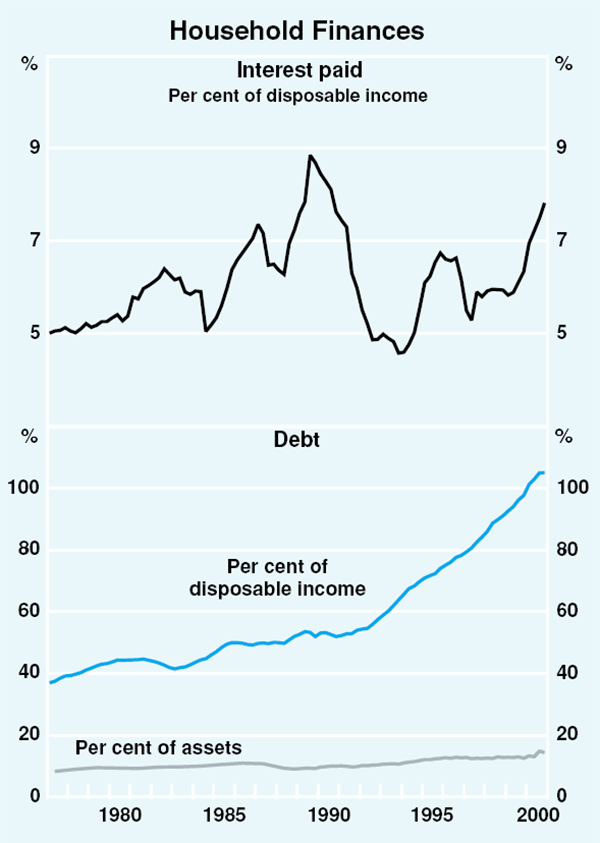
Dwelling investment
Dwelling investment contracted sharply in the second half of 2000. In the December quarter, dwelling construction activity, as a share of real GDP, fell to its lowest level in 40 years, after achieving its highest level in 20 years just two quarters earlier (Graph 27). The sharp turnaround was evident in spending on both new construction and alterations and additions. The effect of tax reform on the timing of housing construction was much more significant in Australia than in other countries that have recently introduced a value-added tax (Graph 28).
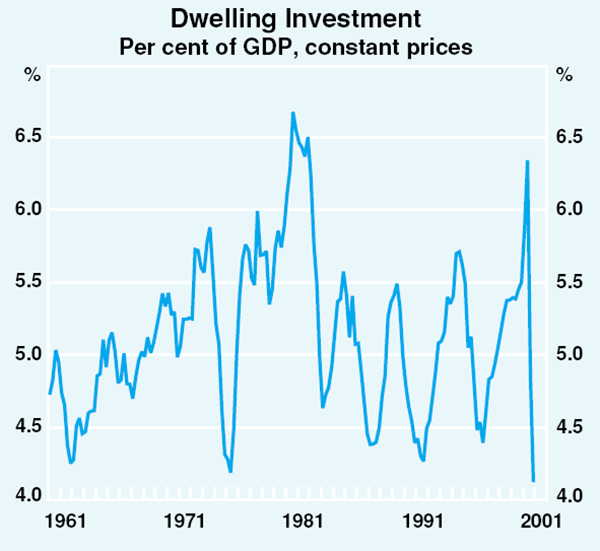
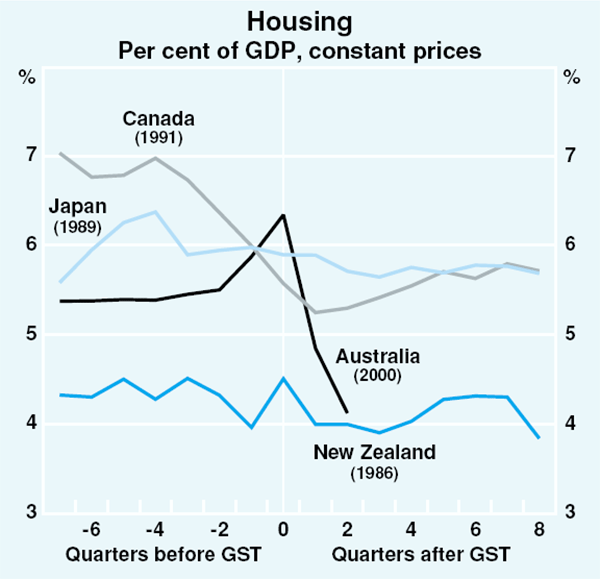
All states experienced a boost to construction activity in the first half of 2000 followed by a substantial contraction in activity in the second half. In the case of New South Wales, and to a lesser extent Western Australia, the contraction in activity followed an extended period in which activity had been running at a high level. For the other states, the run-up in activity was concentrated in the first half of 2000.
To date, there is little evidence at an aggregate level of significant over-building of dwellings during the recent upswing. According to the Real Estate Institute of Australia (REIA), vacancy rates, after drifting higher following the mid-1990s boom in dwelling investment, have been fairly steady in most capital cities, although in Perth there have been some signs of an increase. Investment in medium-density dwellings has, however, been at a high level for several years, and most of this activity has been concentrated in NSW and Victoria. It is possible that the recent concentration of activity has resulted in some degree of over-building in some areas.
The precise timing of the recovery in dwelling investment remains unclear. Near-term indicators of dwelling investment are at low levels with lending approvals for new dwellings, building approvals and commencements remaining close to their recent troughs (Graph 29). On the basis of these figures, the possibility of a further fall in dwelling investment having occurred in the March quarter cannot be ruled out.
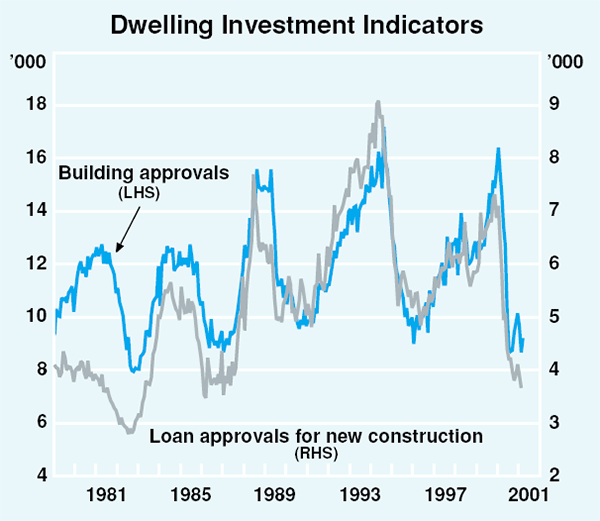
Despite this near-term uncertainty, recent developments in the housing market overall are quite favourable for dwelling construction activity in the period ahead. Loan approvals for owner-occupiers' purchases of established dwellings and newly erected dwellings have picked up sharply in recent months and have recovered much of the post-GST fall (Graph 30). (On average, the market for established houses leads the new construction market by three to four months.) More generally, the improvement in affordability driven by recent falls in interest rates, and the extension to the First Home Owner Grant (FHOG) scheme should spur growth in construction over the remainder of 2001. Indeed, survey data published by the Housing Industry Association suggest a very substantial increase in sales of new homes occurred in March after the extension of the FHOG scheme.
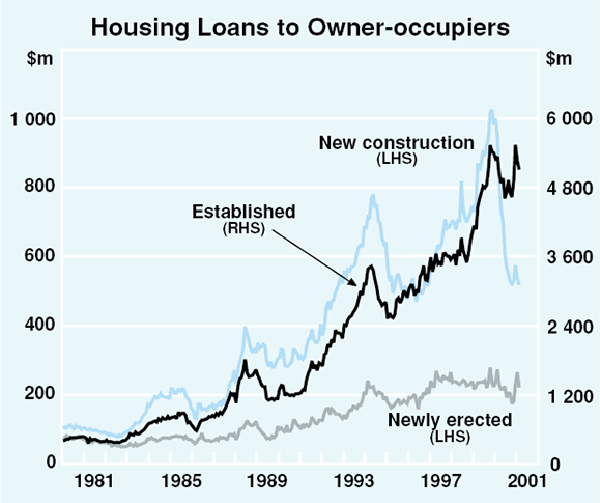
The business sector
Within the business sector, the effects of the sharp swings in dwelling investment and the staging of the Olympic Games in September/October have been clearly evident. In the second half of 2000, weakness was concentrated in the construction and manufacturing sectors, with those parts of the manufacturing sector with strong links to the housing sector, notably wood and paper production, recording particularly weak outcomes. Output in the recreation and culture sector, which was boosted by the recording of the Olympic Games in the September quarter, fell significantly in the December quarter. On the positive side, business and property services, and health and community services continued to expand, and the mining sector reported one of the strongest increases in production, at around 10 per cent over the year.
In recent months, business surveys have continued to report weak business conditions across many sectors of the economy. The business conditions indices in the quarterly NAB survey, which covers a broad range of industries, have remained slightly below the levels prevailing in the mid-1990s slowdown, but are considerably above the levels prevailing in the early-1990s recession. Some variation in conditions across industries is evident in the industry breakdown provided by the NAB survey (Graph 31). Business conditions for the construction industry, for example, have deteriorated most markedly over the last twelve months to well below long-run average levels. On the other hand, conditions in the mining sector have improved sharply over the past couple of years and are well above long-run average levels. The deterioration in business conditions across most other industries over the past year has been broadly similar, although conditions remain only a little below long-run average levels. Other surveys, such as the ACCI-Westpac survey, which covers the manufacturing sector, and the Dun and Bradstreet survey, which covers the retail trade, wholesale trade and transport sectors, have exhibited similar trends.
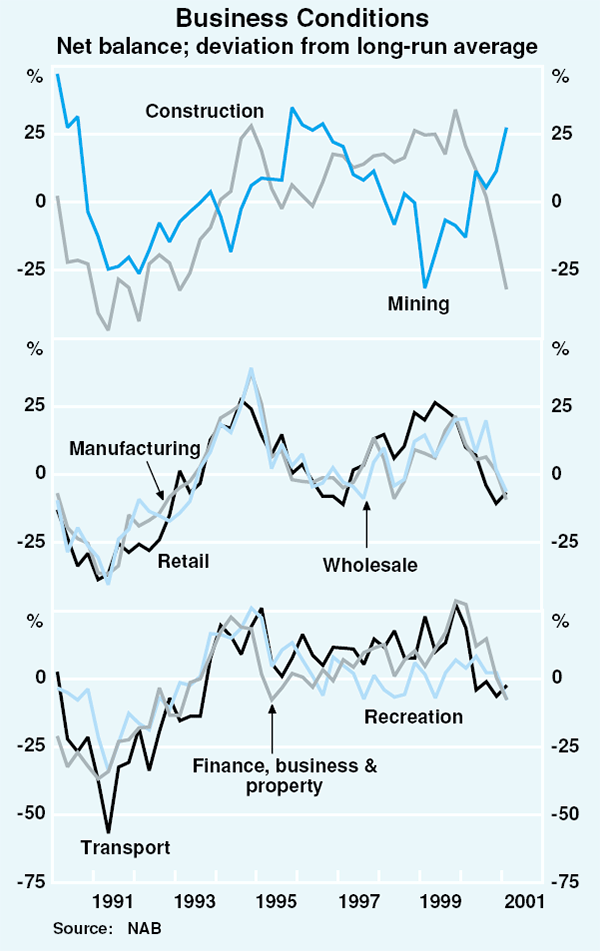
The evidence suggests that the recent fall in sales and business confidence has been more pronounced for the small business sector than for medium and large businesses (Graph 32). (See Box A for a discussion of the employment and output composition of the small business sector.) The ABS quarterly survey of business expectations has reported falls in expected operating income for the small business sector for the last four quarters, whereas the rate of growth of expected operating income for large firms, although weaker, has remained positive. The Yellow Pages survey of small businesses has also reported a more marked deterioration in confidence than most other surveys, with the net balance in recent quarters being at the lowest level since the survey commenced in 1993.
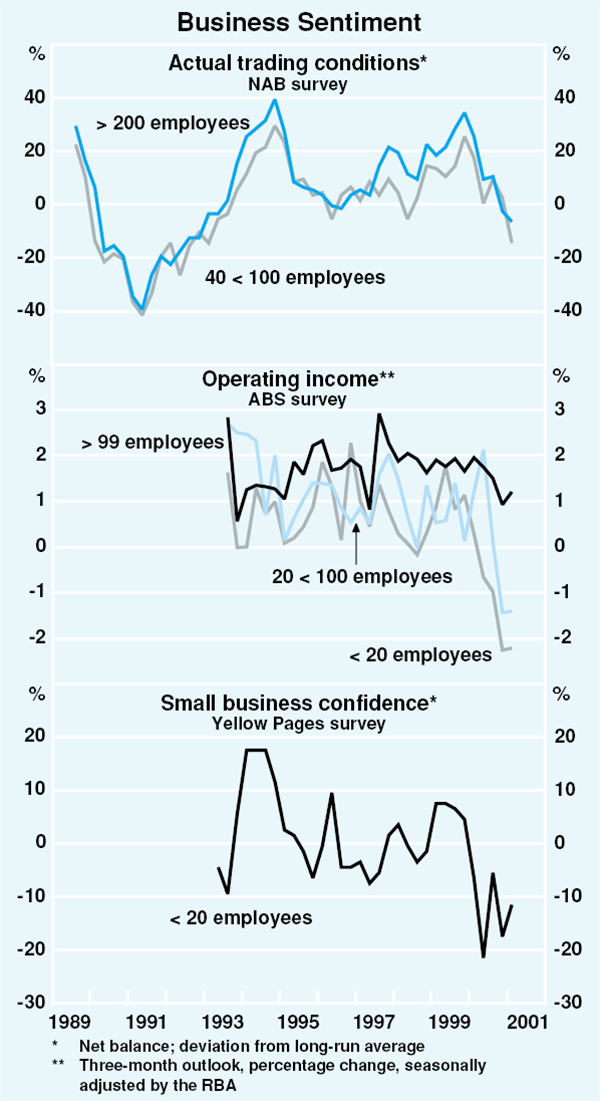
The Yellow Pages survey provides some indication of the source of small business concerns. The most commonly identified concern is a lack of work or sales. In part, this may reflect the small business sector's disproportionately large share in the construction, manufacturing and retail trade sectors. Output of these three industries fell by more than 7 per cent over the second half of 2000, compared with a rise of 2 per cent for other industries. The Yellow Pages survey has also reported an increase in the number of respondents citing government regulations and taxes as a prime concern over the last year and a half, although these concerns eased considerably in the latest survey.
Overall, these surveys have suggested that apprehension about demand, given the weakening in economic conditions, combined with the transitional effects of bedding down the new taxation system, may have led to some compression in profit margins. This has been reflected in aggregate measures of profitability for the unincorporated sector, which have also been weak, with GOS of the unincorporated sector falling by almost 2 per cent in December to be just 1 per cent higher over the year (Graph 33). Although GOS of the unincorporated sector is not estimated at an industry level, the recent fall probably reflects declines in profitability in the retail trade and residential construction sectors.
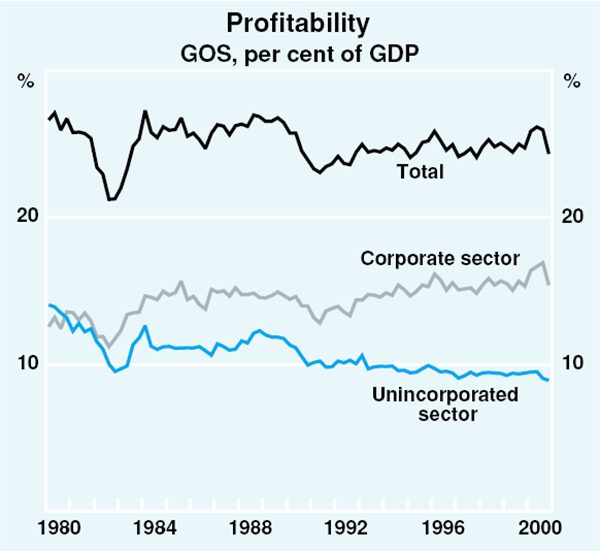
For the corporate sector, aggregate measures of profitability have also fallen. GOS of the corporate sector declined in the December quarter, although it remained 7 per cent higher than a year earlier and, as a proportion of GDP, profits remained above long-run average levels. At an industry level, the ABS Company Profits Survey suggested that the mining sector has continued to benefit from the low exchange rate, with profits growing by 5½ per cent in the December quarter to be more than 30 per cent higher over the year. In contrast, manufacturing profits fell by 7½ per cent in the quarter, following little growth over the previous few quarters.
The decline in profitability and increased uncertainty about the economic outlook were reflected in subdued investment spending in the December quarter. New business investment fell by just over 3 per cent, reflecting significant falls in machinery and equipment and non-dwelling construction activity. Investment in machinery and equipment fell by 5½ per cent in the December quarter, but was around 11 per cent higher than a year ago. It continues to exhibit volatility from quarter to quarter, a pattern seen since the beginning of 1999. The short-term outlook for investment in machinery and equipment, as measured in the latest ABS Capital Expenditure Survey, has been revised down, and implies only modest growth for the remainder of 2000/01. However the first estimate for 2001/02, while only indicative of likely developments, implies a marked rebound in capital expenditure next year. Strong growth in investment is expected to come from the utilities, property and business services, communications and mining sectors.
New investment in buildings and structures has continued to decline from the peak levels reached two years ago, falling by nearly 3 per cent in the December quarter. The first rise in engineering construction in a year and a half was more than offset by a fall in building activity. Forward indicators for non-residential building activity point to little growth in construction work over the remainder of 2000/01. Non-residential building approvals are only slightly above their average level of last year, while the value of building projects under construction, as measured in the Access Economics Property Monitor, fell to its lowest level since 1996. The longer-term outlook for office construction (around 20 per cent of building activity) is somewhat brighter, underpinned by a gradual tightening in market conditions. According to the Property Council of Australia, CBD office vacancy rates fell in most capital cities in the six months to January 2001, as a result of continued strong absorption of office space. Given the long lead times for these major construction projects, however, a recovery in this market is not expected to boost growth in the near term.
Other private business investment (mainly expenditure on computer software but also on mining exploration) increased by 4½ per cent in the December quarter to be nearly 14 per cent higher than a year earlier, suggesting that companies were continuing to invest in information technology. Private expenditure on petroleum exploration also rose significantly, and expectations reported for the six months ended June 2001 suggest that this pattern is likely to continue. Such a pattern would be consistent with the high levels of commodity prices in Australian dollar terms, and the fact that the mining sector is currently operating at very high levels.
In aggregate, business financing activity in the form of both debt and equity has been subdued early in 2001. Although business credit growth picked up in the March quarter, the pattern of growth, with strong growth in February easing in March, is consistent with some of the increased borrowing being used for tax payment purposes. This has also been implied by recent business surveys and liaison with banks. The measured corporate net interest burden rose in the second half of 2000, although compared with earlier episodes, the debt-servicing burden remains at very low levels for both the corporate and unincorporated sectors (Graph 34). Recent falls in interest rates should result in a fall in these debt-servicing ratios in coming quarters.

The labour market
The recent slowing in output growth has seen the labour market weaken significantly over the last two quarters, following the strong conditions prevailing over the past couple of years (Graph 35). Employment grew by 0.2 per cent in the March quarter, recovering almost half of the fall in the December quarter, to be 1.6 per cent higher than a year earlier. The recovery in the March quarter was wholly in part-time employment, with the number of persons employed on a full-time basis continuing to decline. The reduced demand for labour has seen the unemployment rate rise by ½ a percentage point from the recent low to 6.5 per cent in the March quarter. (These data incorporate revisions to the Labour Force Survey data, released in early May, which have reduced the unemployment rate by around ¼ of a percentage point.)
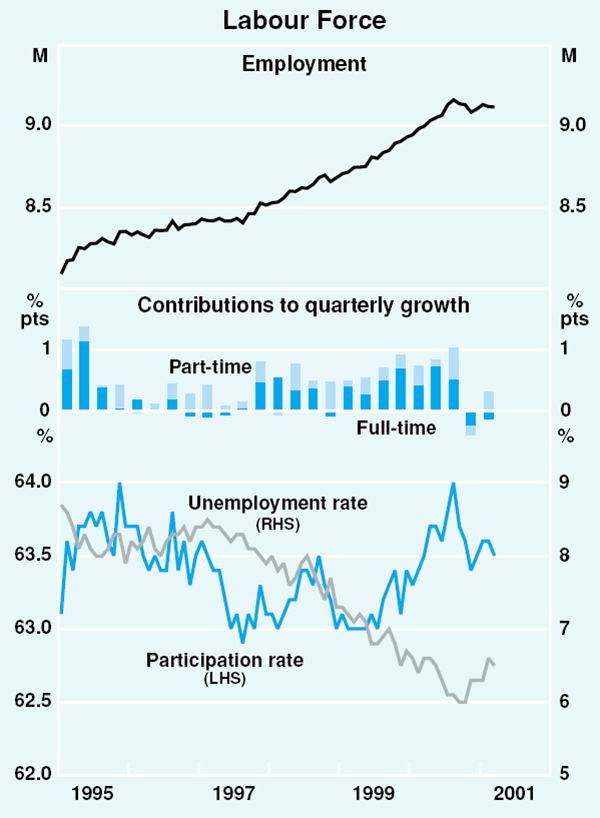
These aggregate data disguise a marked variation in outcomes across industries, occupations and regions. Overall, robust demand for professionals and office workers has been offset by reduced demand for tradespersons and labourers. Not surprisingly, the construction industry has driven the recent weakening in employment outcomes. Over the six months to February, employment in construction fell by 48,300, while in the rest of the economy it grew by 40,800 (Graph 36).
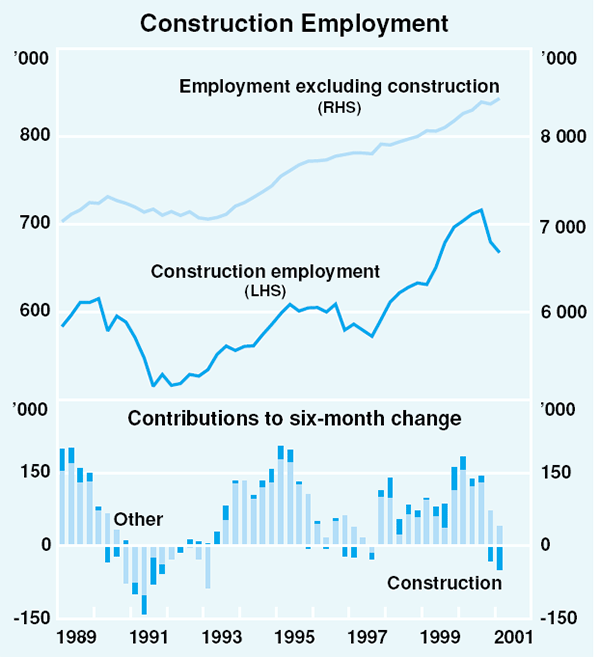
The recent decline in output has also affected employment in a range of traditionally cyclically sensitive industries, including wholesale and retail trade and manufacturing. In contrast, high levels of labour demand have persisted in most service industries. Employment in the property and business services sector, for example, has grown by over 120,000 over the past year and by more than 30,000 in the March quarter, with strong growth in employment in the accounting, legal and information-technology areas.
The labour market has weakened, to varying degrees, in every state over the past six months. New South Wales has experienced one of the most pronounced contractions, while employment growth has remained strongest in Victoria and Western Australia (Table 6).
| NSW | Vic | Qld | WA | SA | Tas | Australia | |
|---|---|---|---|---|---|---|---|
| Employment growth | |||||||
| – Two quarters to Sep 2000 | 2.0 | 2.6 | 2.3 | 0.3 | 1.1 | 0.0 | 1.9 |
| – Two quarters to Mar 2001 | −1.1 | 1.0 | −1.0 | 1.1 | −1.4 | 0.7 | −0.2 |
| Unemployment rate | |||||||
| – March quarter 2001 | 5.7 | 6.0 | 8.2 | 6.5 | 7.0 | 8.6 | 6.5 |
The different labour market conditions in the states have largely reflected differences in their exposure to the downturn in the construction industry (Table 7). Employment increased most rapidly in New South Wales prior to the September quarter 2000, but has fallen by almost 35,000 over the past two quarters, driven by a loss of construction jobs. Weakness in the construction sector has also been a key factor in the relatively weak labour market outcome in Queensland. These two states have also experienced floods, and around half of the jobs lost in the agricultural industry in NSW occurred in flood-affected local government areas. In contrast, Victoria has been less exposed to the downturn in the construction industry and, in fact, has achieved small gains in construction employment over the past year. Furthermore, strong employment growth has been recorded in Victoria in a range of service industries, both business-related services and those connected to the public sector. Consistent with the relative strength of the labour market in Victoria, that state has been experiencing net inflows of interstate migrants for the first time in many decades.
| Construction | Manufacturing, trade & transport(a) |
Agriculture | Business services(b) | Public- related(c) |
Other(d) | Total(e) | |
|---|---|---|---|---|---|---|---|
| NSW | −32.6 | −8.9 | −13.3 | 52.5 | 21.2 | 0.6 | 20.0 |
| Vic | 3.6 | 10.2 | 9.6 | 18.6 | 49.3 | −0.1 | 87.3 |
| Qld | −8.1 | −8.8 | −18.5 | 24.9 | 15.9 | 6.3 | 8.9 |
| SA | −6.0 | 3.0 | −6.2 | 10.9 | 0.3 | 0.0 | 2.6 |
| WA | 3.6 | −15.7 | −0.2 | 12.5 | 10.0 | 2.9 | 12.0 |
| Tas | 1.9 | 3.0 | −3.1 | 2.7 | −0.7 | −0.9 | 3.0 |
| Australia(e) | −36.5 | −26.0 | −31.4 | 122.2 | 100.9 | 6.7 | 135.9 |
| (a) Manufacturing; wholesale and retail trade; and transport and storage
(b) Property and business services; finance and insurance; and communications (c) Education; health and community services; public administration and defence; and utilities (d) Mining; accommodation, cafés & restaurants; cultural and recreational services; and personal and other services (e) Totals incorporate the recent revisions to the Labour Force Survey data; includes ACT and NT |
|||||||
Growth in labour productivity has eased over the past couple of years, from a rate of around 3½ per cent two years ago, to around ¾ of a per cent over the year to the December quarter 2000 (Graph 37). Measures of labour productivity growth, however, vary quite considerably across the business cycle, given variations in the lags between employment and economic activity, so changes in the longer-term trend rate of productivity growth are not readily discernible from these data. To date, the easing in labour productivity growth appears similar to the cyclical slowing that occurred in the mid 1990s.

Most forward-looking indicators of labour demand suggest that employment will be weak over the next couple of quarters. Both the ANZ Bank and the Department of Employment, Workplace Relations and Small Business (DEWRSB) measures of vacancies indicate that the number of jobs advertised in newspapers continues to fall quite sharply and is now a third below the peak in May 2000 (Graph 38). According to the DEWRSB measure, most of the fall in vacancies over the past year has been the result of a sharp decline in the level of advertising of positions related to the construction sector and, to a lesser extent, in manufacturing. The continuing decline in advertisements for tradespersons, which are now at a low level, suggests a comparatively weak employment outlook for this occupational grouping in the short term. Advertising for professionals, in contrast, has been considerably stronger, and although a fall was recorded in April, it remains at an historically high level.
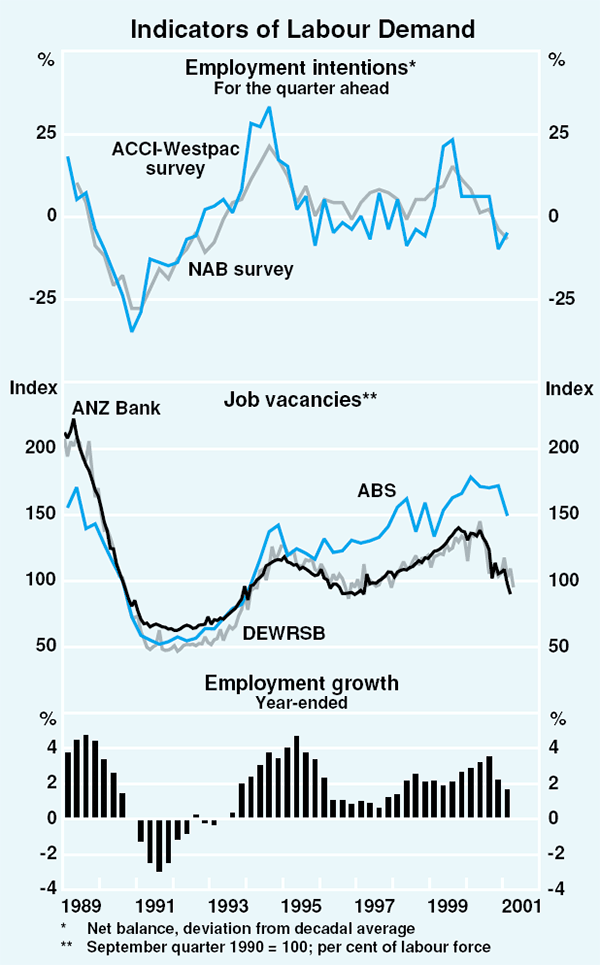
The recent divergence between trends in the number of jobs advertised in newspapers and the number of job vacancies as measured by the ABS has been partially resolved following revisions to the ABS vacancies data. The ABS data now show that vacancies peaked in February 2000 and have since declined by 15 per cent. This fall, however, remains considerably less than that recorded by the newspaper-based vacancies series. This may reflect the nature of the ABS survey: since it is a survey of employers' direct hiring intentions, it is less representative of employment developments in industries in which sub-contracting is prevalent and self-employed workers are highly represented. This is clearly relevant for the construction industry, and may help to explain why the ABS reports that vacancies in this industry have been flat over the year to February, while the DEWRSB skilled vacancies measure of job advertisements (which includes advertisements for construction sub-contractors) reported a fall of around 75 per cent over the same period. The recent declines in the ABS vacancies measure have been most pronounced in the manufacturing and retail trade sectors, and have been broadly consistent with movements in employment in these sectors.
The major surveys of business expectations also point to a subdued outlook for the labour market. The quarterly NAB survey reported that employment intentions continued to decline into the June quarter 2001, while the ACCI-Westpac survey indicated that employment intentions in the manufacturing sector improved slightly in the quarter, although they remain quite soft. Although employment intentions remain near their lowest levels in recent years, at present they are considerably more buoyant than those prevailing immediately prior to the early-1990s recession.
Box A: Small Business in the Economy
There are over one million small businesses in Australia, accounting for 95 per cent by number of all businesses and around 30 per cent of private sector output.[1] These businesses cover a wide range of activities, from tradespeople, to professionals, to small manufacturing or retailing concerns. Over half of small businesses consist only of the owner (or owners in the case of a partnership), with no employees. The average number of employees across all small businesses in 1999/2000 was around three. Consequently, small businesses employed around 40 per cent of the total workforce, or around 50 per cent of the private-sector workforce. In recent years, the number of people working in small businesses has grown broadly in line with that of the economy as a whole.
Small businesses are found in all the industry sectors of the economy, though they are more prevalent in some areas than others. The largest numbers of small businesses are in the property and business services, construction and retail sectors (Table A1). These industries account for around one-half of total employment in small businesses. In the construction sector, over three-quarters of the workforce are employed by small businesses, reflecting the importance of independent contractors in this industry. Small businesses account for a similarly large share of employment in agriculture. In contrast, small businesses employ less than 20 per cent of the workforce in the mining and finance and insurance sectors.
| Number of small businesses ’000s |
Employment | Sales(b)
Share of industry |
Operating profit before tax(b) Share of industry |
||
|---|---|---|---|---|---|
| ’000s | Share of industry |
||||
| Agriculture(c) | 100 | 249 | 74 | na | na |
| Mining(c) | 2 | 9 | 12 | 12 | 36 |
| Manufacturing | 86 | 275 | 29 | 13 | 28 |
| Construction | 209 | 474 | 82 | 55 | 68 |
| Wholesale trade | 64 | 244 | 43 | 31 | 24 |
| Retail trade | 165 | 590 | 48 | 43 | 69 |
| Accommodation, cafes & restaurants | 31 | 183 | 44 | 40 | 44 |
| Transport & storage | 64 | 163 | 52 | 21 | 19 |
| Finance & insurance | 24 | 58 | 20 | 30 | 40 |
| Property & business services | 207 | 584 | 55 | 47 | 57 |
| Education | 25 | 65 | 31 | na | na |
| Community services | 69 | 230 | 43 | 46 | 71 |
| Culture & recreation | 38 | 91 | 47 | 15 | 18 |
| Personal & other services | 77 | 184 | 71 | 52 | 43 |
| Total private sector(d) | 1,175 | 3,430 | 49 | 30 | 39 |
|
(a) Excludes public sector Source: ABS Cat No 1321.0 |
|||||
While small businesses account for around 50 per cent of total private sector employment, they account for only around 30 per cent of sales and output. In part this reflects the concentration of small businesses in labour-intensive industries such as construction and retail trade. For the same reason, the investment rate of small businesses (measured by capital expenditure as a share of industry value added), at around 16 per cent in 1998/99, was lower than for large businesses which was around 27 per cent. The average hours worked in the small business sector tends to be higher than in the rest of the economy. In 1998/99, over one-quarter of small business operators worked at least 51 hours a week, compared with less than 20 per cent for the workforce as a whole.
The rate of turnover of small businesses tends to be higher than for the rest of the economy. According to the Productivity Commission, in 1995/96 almost 8 per cent of small businesses ceased operations compared with around 5 per cent for medium and large businesses. The rate of small business formation is also much higher than for large firms. This implies that each year a disproportionately large share of new jobs tends to be created by small businesses. For example, in 1997/98, half of all the new jobs created in the economy were in small businesses, spread equally between new businesses starting operations and existing businesses expanding their operations. However, at the same time, half of all the jobs lost in the economy were also in small businesses, with the majority of these in businesses that ceased operations during the year.
The commercial structure of small businesses differs quite markedly from larger businesses. In 1998/99 around 43 per cent of small businesses with employees were incorporated, compared with 70 per cent for larger businesses; 17 per cent of small businesses were sole proprietorships and 38 per cent were partnerships and trusts. In the first half of 2000, there was a noticeable increase in the rate of incorporation, some of which may have been related to the introduction of the new tax system. Subsequently, the number of incorporations has slowed significantly to be around two-thirds of the rate in the first half of 2000.
ABS data suggest that, measured in simple terms, the rate of profitability is higher in small firms than larger firms. But this comparison is potentially misleading, since the income of the manager, who is often also the owner, might be taken as profits in the case of small firms but as a wage or salary in the case of larger firms. Hence no strong conclusion can be drawn from this comparison. Small firms tend to be more reliant than larger firms on borrowing from financial institutions as a source of funding. They generally do not have easy access to raise money from capital markets directly either in the form of equity raisings or by issuing corporate bonds, but rather depend on intermediated finance.
Balance of Payments
The external sector has provided a considerable impetus to the economy over the past year, contributing one percentage point to the growth in GDP over the year to the December quarter 2000. Strong world growth and a low exchange rate boosted export volumes, while a slowing in domestic demand and the lower exchange rate retarded growth in imports. The terms of trade have also moved favourably, increasing to their highest level in ten years. The trade balance recorded a trade surplus of $212 million in the March quarter, or around 0.1 per cent of GDP (Graph 39). Assuming the net income deficit is steady as a share of GDP, the current account deficit in the March quarter is likely to have fallen below 3 per cent of GDP, from the peak of 6 per cent recorded in the middle of 1999. In the period ahead, the external sector will be affected by the opposing forces of a more subdued outlook for world growth and the low exchange rate.
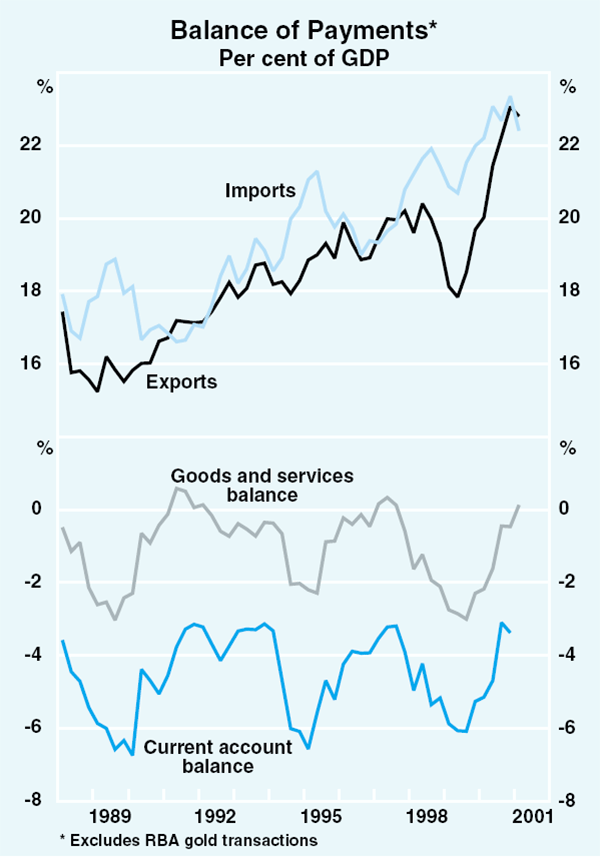
The value of exports increased by more than 17 per cent over the year to the March quarter. The slight fall in the March quarter reflected a number of factors including adverse weather affecting the supply of rural exports and the slowdown in growth in the world economy. The fall in the quarter was spread across all major destinations, but was smallest to east Asia (excluding Japan) (Graph 40). Over the past year, exports to east Asia have recorded the fastest pace of growth so that the share of exports to this region has risen from 31 per cent of total merchandise exports to 36 per cent over the past two years. Much of this growth has been in resource exports, particularly petroleum, metals and iron ore.

The value of rural exports fell by around 3 per cent in the March quarter to be 16 per cent higher than a year earlier (Graph 41). A decline in cereal exports, largely a result of unfavourable weather conditions, accounted for much of the fall in the quarter. In south east Queensland and northern New South Wales, extremely wet weather around harvest time resulted in a substantial downgrading of the quality of the harvest. Despite the recent decline, the outlook for the rural sector is positive. Export receipts for a range of Australian products are likely to rise in response to agricultural trade restrictions now imposed on countries afflicted with foot-and-mouth disease.
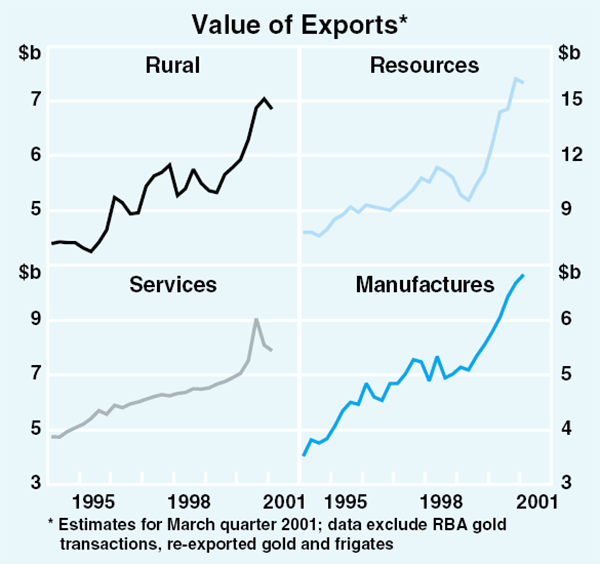
After increasing strongly over the previous year and a half, the value of resource exports declined a little in the March quarter, as a fall in prices received more than offset solid growth in export volumes. Exports of many resource commodities remain at high levels despite the recent slowing, resulting in a run-down in inventories. Some areas of the mining industry may be approaching full capacity, which may limit the growth in resource exports volumes in the period ahead.
The low level of the exchange rate has boosted manufactured exports, although more recently, weaker trading partner growth has contributed to a slowing in the rate of growth. The value of manufactured exports rose by 2 per cent in the March quarter to be 18 per cent higher than a year earlier. An increase in exports of manufactures such as motor vehicles more than offset a fall in the value of machinery and equipment exports in the quarter.
Following the Olympics-related surge in overseas arrivals in September, the value of service exports has fallen over the past two quarters. Overseas arrivals are still above their pre-Olympics level, however, with a decline in the number of visitors from the US and Europe being partially offset by a recovery in tourist arrivals from east Asia and New Zealand. Within east Asia, arrivals from China, Korea and Singapore have been particularly strong in recent months.
The value of imports of goods and services fell in the March quarter, driven primarily by a weakening in domestic demand. The largest fall was in imports of capital goods (Graph 42). Consumption imports had grown strongly over the second half of 2000, supported by firm growth in the volume of motor vehicle imports. More recently, however, that effect has been unwinding, with the value of motor vehicle imports falling by more than 13 per cent in the March quarter, accounting for the majority of the fall in the value of consumption imports in the quarter. The value of intermediate imports has fallen, following a sharp oil-related rise in 2000. Service imports rose marginally in the March quarter and are around 10 per cent higher over the year. Reflecting the effect of the low exchange rate on the cost of overseas travel, the volume of travel services declined over 2000.
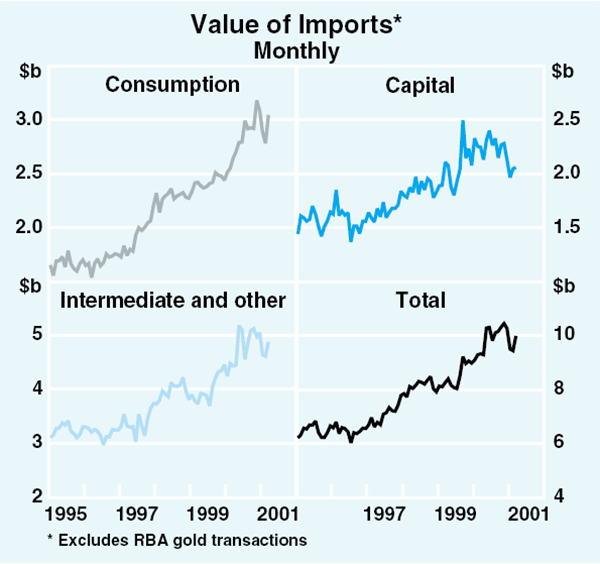
The net income deficit widened slightly in the December quarter to around 3 per cent of GDP. The trend since the mid 1990s, however, has been for the net income deficit to narrow, reflecting in part the falling differential between debt yields in Australia and other countries. Combined with strong growth in exports, this has resulted in the ratio of net interest payments to exports falling to around 9 per cent, from around 12 per cent in the mid 1990s.
Australia's net foreign debt increased by 2 per cent in the December quarter to just over $300 billion, or 46 per cent of GDP. Net equity liabilities rose by a greater margin in the quarter, reflecting the valuation effect of the stronger performance of the Australian stock market relative to those abroad. The ABS has substantially revised the value of Australians' holdings of equities abroad to more accurately reflect their market value. This had the effect of lowering the level of Australia's total net foreign liabilities as a proportion of GDP by around 8 percentage points in the September quarter, with revisions to the level in earlier years too. Australia's net foreign liabilities are now estimated to be 58 per cent of GDP.
Over 2000, net capital inflows were predominantly in the form of debt rather than equity (Table 8). One factor underpinning this shift in the past two years has been the increased volume of portfolio investment by Australians in foreign equities while portfolio equity inflows have also declined.
| 1997 | 1998 | 1999 | 2000(a) | |
|---|---|---|---|---|
| Debt | ||||
| Inflow | 3.4 | 1.5 | 6.2 | 5.4 |
| Outflow | 2.3 | 0.2 | 3.0 | −0.4 |
| Net | 1.1 | 1.3 | 3.1 | 5.0 |
| Equity | ||||
| Inflow | 4.0 | 4.7 | 2.7 | 1.0 |
| Outflow | 1.8 | 1.5 | 0.6 | 2.0 |
| Net | 2.2 | 3.3 | 2.1 | −0.9 |
| (a) Through the September quarter | ||||
Commodity prices
The Bank's index of commodity prices increased by around 1½ per cent in foreign-currency terms in the three months to April, to be about 7 per cent higher than the corresponding period last year (Graph 43). In Australian dollar terms, the increase has been much greater, with the index increasing by around 6 per cent in the three months to April and by 22 per cent over the year. Commodity prices, in Australian dollar terms, are at their highest level in more than two decades. Rural prices have accounted for much of the recent increase, along with higher coal prices. In contrast, base metal prices have been adversely affected by the downturn in the world economy.
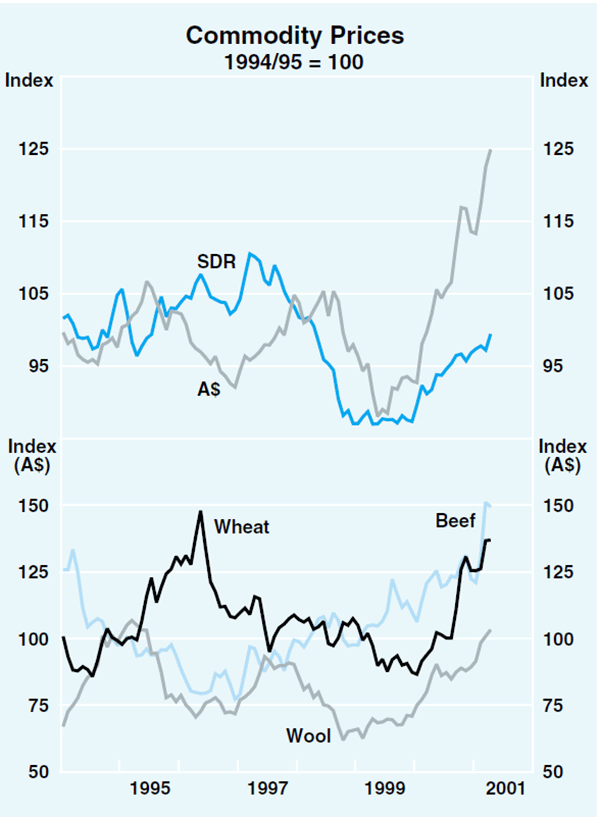
The rise in rural prices has been broad-based. Wool prices rose by around 8 per cent in foreign-currency terms in the three months to April, mainly reflecting stronger demand from China. Beef and veal prices have increased by around 10 per cent in the three months to April, following the outbreak of foot-and-mouth disease in the major beef-exporting countries of Europe and South America. Sugar prices fell by around 5 per cent in the three months to April, reflecting weaker than expected demand from Russia, though they are still 70 per cent higher than a year earlier. The price of cotton has fallen by about 14 per cent in the past three months on expectations that the 2001 worldwide harvest will be the largest in over a decade.
Recently negotiated contracts have delivered large rises in the prices of iron ore and some forms of coal. For the Japanese fiscal year beginning in April, US dollar prices of iron ore increased by an average of 3 to 4 per cent. Coking coal prices have increased by about 8½ percent over the year, while steaming coal prices have increased to an even greater extent. Strong Asian demand and tight supply in the region have seen the average price of steaming coal rise by around 20 per cent in US dollar terms and by 36 per cent in Australian dollars over the past year. These increases will be reflected in Australia's export prices from the June quarter.
Reflecting the slowdown in global industrial production, base metal prices were unchanged in the March quarter, and have fallen by around 2½ per cent over the year (Graph 44). An exception to this is the price of aluminium, which has remained firm as smelter closures in the US have caused production to fall more quickly than demand.
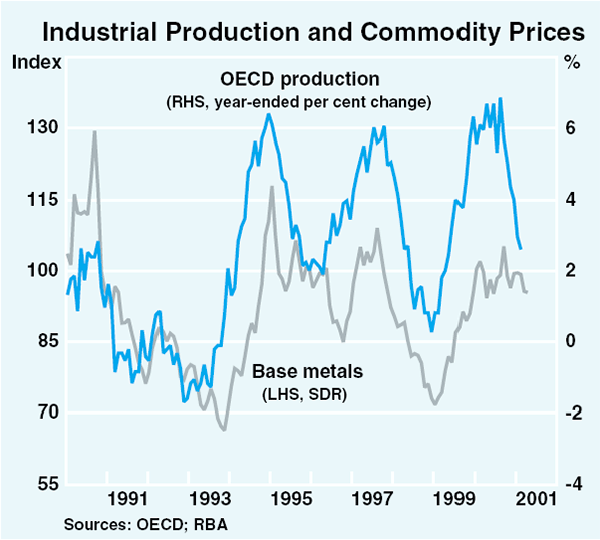
Oil prices have drifted lower over the past few months, with the price of West Texas intermediate now trading at around US$27–28 per barrel. The weaker outlook for world growth has been the major factor, though the effect of this has been countered by threats by OPEC to reduce production. OPEC members have only cut production once this year – agreeing in March to reduce production by about one million barrels per day.
Domestic Financial Markets
Market interest rates
At the short end of the yield curve, attention has focused on reductions in the cash rate by the RBA. The three monetary easings (50 points in February, 25 points in March and 50 points in April) reduced the cash rate to 5 per cent, only marginally above its two previous cyclical lows.
The easings in February and March had been anticipated by markets and fully priced into yields by the time they were announced. In the case of the April easing this was less so, as the market was divided as to whether that reduction would be 25 or 50 points. When the larger figure was announced, there was consequently some further fall in market yields. Looking at the overall movement in the year to date, short-term market yields have broadly fallen by the same amount as the cash rate (Graph 45).
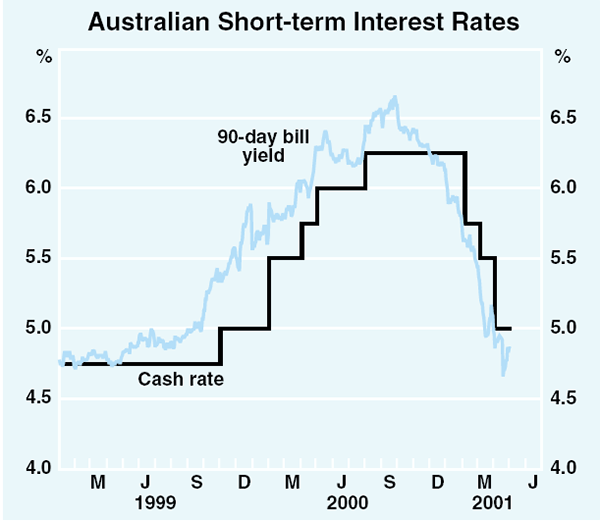
The current structure of the yield curve at the short end suggests that markets, as at the time of writing, were expecting some further easings in monetary policy in the months ahead. These expectations were scaled back somewhat after the release of the higher-than-expected CPI result for the March quarter, but still incorporate a view that the cash rate will level out at around 4.5 per cent in the second half of the year. This is a higher level than the expected Fed funds rate in the second half of the year, which is around 4 per cent.
Yields at the long end have taken a somewhat different course. In the middle of 2000, they had been around 6.25 per cent, broadly in line with the cash rate and short-term yields. They then fell quite sharply during the December quarter (largely in line with US bond yields) and were around 5.5 per cent by the end of that quarter (Graph 46). They then fell further during the March quarter, reaching a low of just below 5 per cent in mid March, similar to the low reached in 1998 after the Asian financial crisis and the collapse of the hedge fund, Long-Term Capital Management.
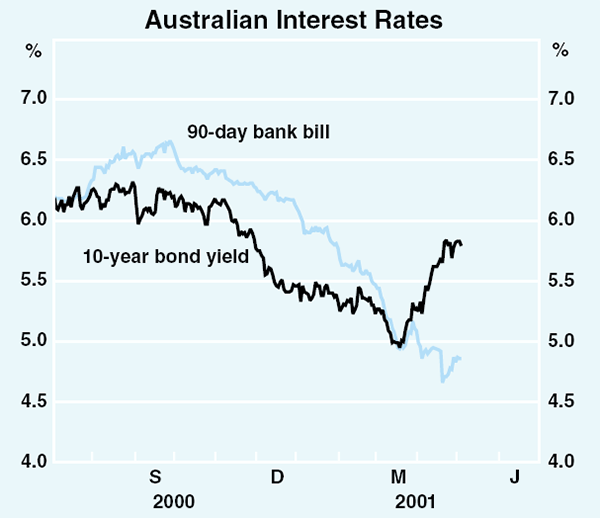
Since mid March, however, even though short rates have fallen further, bond yields have risen quite noticeably, back to December quarter levels. As with the earlier fall, this rise seemed mainly due to US market developments, but also appeared to indicate a diminished concern among markets about the downturn in the domestic economy.
The differential between Australian and US bonds generally traded in the range of 10–50 points over the past nine months (Graphs 47 and 48). On average, this was similar to the spread over the past three years, and well below historical norms when Australian inflation substantially exceeded that in the US. In recent weeks, the bond spread has tended to trade around the top end of the range noted above, and on some days somewhat above it. This mainly reflected a view that economic activity in Australia would prove to be more robust than in the US, though the relatively high CPI outcome for the March quarter also seemed to add to the spread, indicating that it may have had some (albeit small) impact on inflationary expectations.
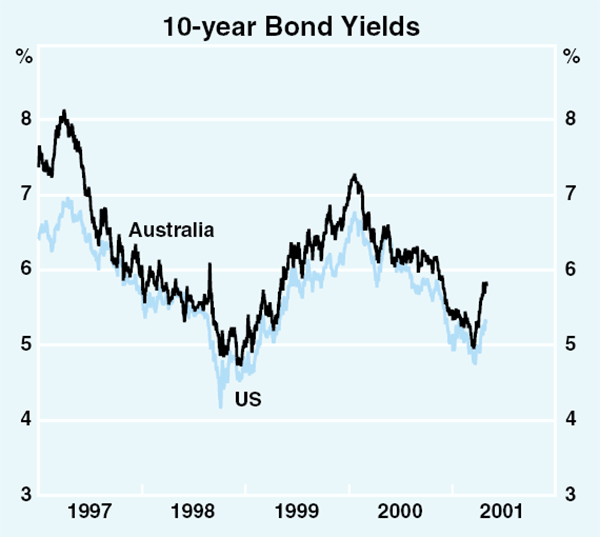
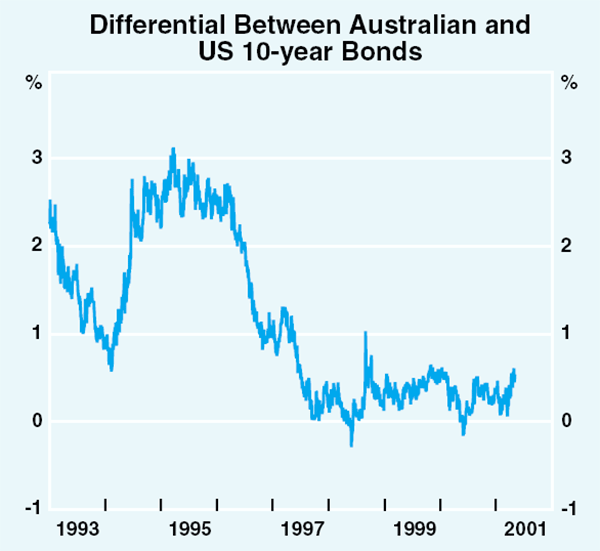
Intermediaries' interest rates
Each of the easings of monetary policy has been passed on very quickly, and in full, to housing borrowers. The pass-through to business loans has been less quick, and in some cases not quite in full. Credit card rates have fallen by much less than the fall in the cash rate. Table 9 summarises movements in the main lending rates charged by intermediaries following the easing in monetary policy of recent months, and the current levels of these rates.
| Change since January 2001 (percentage points) |
Current level (per cent) |
Cyclical low in 1998/99 (per cent) |
|
|---|---|---|---|
| Cash rate | −1.25 | 5.00 | 4.75 |
| Household | |||
| Mortgages | |||
| – Standard-variable | −1.25 | 6.80 | 6.50 |
| – Basic | −1.25 | 6.25 | 5.90 |
| – Mortgage managers | −1.25 | 6.55 | 6.10 |
| Personal lending | |||
| – Residential secured | −1.20 | 7.00 | 6.60 |
| – Credit cards | −0.70 | 16.00 | 15.25 |
| Small Business | |||
| Residential secured: | |||
| – Overdraft | −1.20 | 7.40 | 6.95 |
| – Term loan | −1.20 | 7.00 | 6.65 |
| Other security: | |||
| – Overdraft | −1.20 | 8.00 | 7.45 |
| – Term loan | −1.25 | 7.45 | 7.05 |
| Large Business | |||
| – Overdraft | −1.25 | 8.50 | 7.95 |
| – Term loan | −1.20 | 8.40 | 7.90 |
Banks, building societies and mortgage managers have passed on to housing borrowers the full 125 basis point easing in policy (see Graph 49). These cuts have reduced the average standard-variable housing rate of banks to 6.80 per cent, only about 30 basis points higher than the level at the cyclical low of 1999 and almost 2 percentage points below the cyclical low in 1993/94. The easings have been passed on to existing housing borrowers much more quickly than in the past, and on average more quickly than banks passed on the tightenings of 1999 and 2000.

Reductions in rates on home equity loans have been slightly less than the cut in the cash rate, as lenders which used to have rates below average have moderated their reductions to bring their rates into line with competitors.
Major banks have passed on only partially interest rate reductions to credit card borrowers. The average interest rate on credit cards (with an interest-free period) is currently 16.00 per cent, a cut of 70 basis points since early 2001. Cuts in rates to business borrowers have, on average, been slightly less than the reductions in the cash rate. As with home equity loans, this reflects the fact that some banks that had been charging relatively low rates have brought them more into line with their competitors. In recent months, small business has generally also had to wait longer than households to see the benefits of cuts in the cash rate.
While business variable-rate loans have moved with the cash rate, interest rates on fixed-rate loans have tracked longer-term rates in capital markets. The 3-year fixed rate for business loans has fallen by just over 200 basis points since its peak in early 2000; this rate has moved up in recent weeks as yields in capital markets have increased. Almost half of small business borrowing is undertaken at fixed rates.
Taking a longer view of developments in finance for small business, interest rates have fallen noticeably, in a structural sense as opposed to cyclically, as banks' margins on these loans have been substantially reduced. The margin between the average interest rate on small business variable-rate loans and the cash rate has almost halved since the mid 1990s, falling from 6.15 per cent in mid 1994, to 3.35 per cent. A major factor in this reduced margin is the migration of borrowing to newly-available low-cost loans, particularly residentially-secured loans. This structural fall in margins meant that, at the peak in rates in the second half of 2000, the average rate paid by small businesses remained 1.5 percentage points below the mid-1990s low point, even though the cash rate was 1.5 percentage points higher.
Capital markets developments
Debt markets
Over the past few months issuance of debt securities by non-government entities has continued at the strong pace seen over the past two years, with net issuance averaging $5.5 billion per quarter since the beginning of 1999. This continued strong growth in the non-government bond market has meant that the level of non-government bonds outstanding, at $89 billion, now substantially exceeds the amount of Commonwealth bonds on issue and is close to the peak in the size of Commonwealth Government bond outstandings ($95 billion) seen in 1997 (Graph 50).
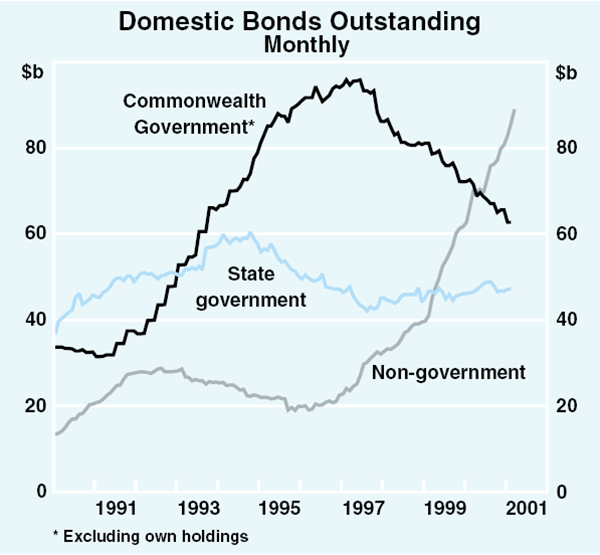
Table 10 shows the composition of gross new issuance in the non-government debt market in recent years. Corporate issuance in the first quarter of 2001 was the lowest since the September quarter 1999, with a large fall in new bond issues by former state-owned utilities. Debt issuance by financial institutions has been higher than the average seen in previous years, and non-resident issuance into the domestic market was particularly strong. The large amount of non-resident issuance was influenced by the low cost of raising funds in Australia and swapping into US dollars. For most of this year, this was cheaper for issuers than the cost of approaching the US markets directly.
| $billions per quarter | 1999 | 2000 | 2001 (Q1) |
|---|---|---|---|
| Financials | 2.6 | 1.3 | 2.1 |
| Non-residents | 1.4 | 0.9 | 3.8 |
| Corporates | 1.6 | 2.0 | 0.5 |
| Asset-backed | 1.7 | 2.7 | 3.0 |
| Total new issuance | 7.2 | 6.9 | 9.4 |
Offshore bond issuance by Australian residents was $7.8 billion in the March quarter. These issues are still larger than domestic issues, but growing at a slower rate (Graph 51). The main issuers to tap the offshore market continue to be financial institutions and, more recently, asset-backed vehicles. Non-financial corporates have had no significant presence in this market since 1999.
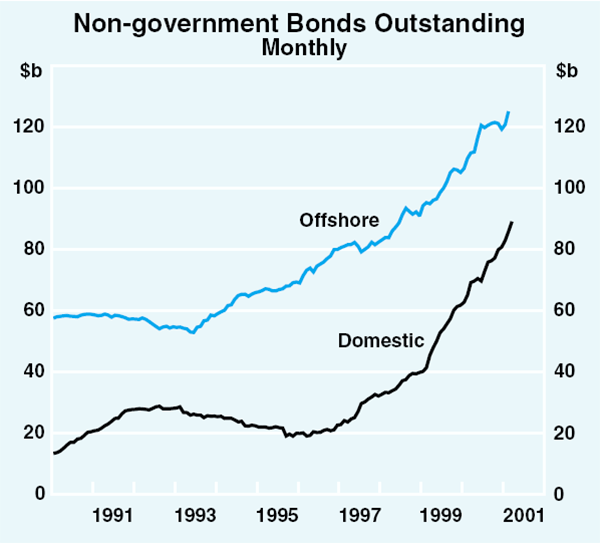
The average credit rating of new issues of corporate bonds (excluding asset-backed issues) rose somewhat in the March quarter 2001, to AA− from A in the December quarter. This strengthening of average credit quality is a slight reversal of the longer-term trend, which has reflected a broadening in the range of companies that are now able to raise funds in the domestic bond market, rather than any deterioration of credit quality among corporations.
The maturity profile of issuance in the latest quarter has been around the middle of the corporate yield curve (maturities between four to six years), a little longer than was the case in the second half of last year. This movement to longer-dated securities went hand-in-hand with the slight rise in the average credit quality of issuers; it remains the case that better-rated companies are able to issue longer-term securities.
Equity markets
The Australian equity market continues to be quite steady by world standards. The ASX 200 index has generally been flat over the past year, a period when most other industrial country share markets have fallen by 10–30 per cent (Graph 52).

The resource sector has been particularly strong, reaching a record high in April. Share prices of these companies have risen 12 per cent so far this calendar year, reflecting the continuing boost to export revenues provided by the low exchange rate and also recent rises in metals prices, particularly for aluminium and copper.
Earnings forecasts for Australian companies have been downgraded more quickly this year than is normally the case. Analysts' forecasts of growth in earnings per share for the ‘all industrials’ sector are now below the growth recorded in 2000, though, at 6 per cent, the forecast increase is still substantial (Graph 53). Estimates for earnings growth in 2002 have also been downgraded, but nonetheless remain high, at 14 per cent. This suggests that the share market analysts are expecting a rapid recovery in economic activity. The market-wide price/earnings (P/E) ratio has fallen from its peak last year of 29, to the low 20s at present (Graph 54). This is, however, still well above the long-run average of 15.

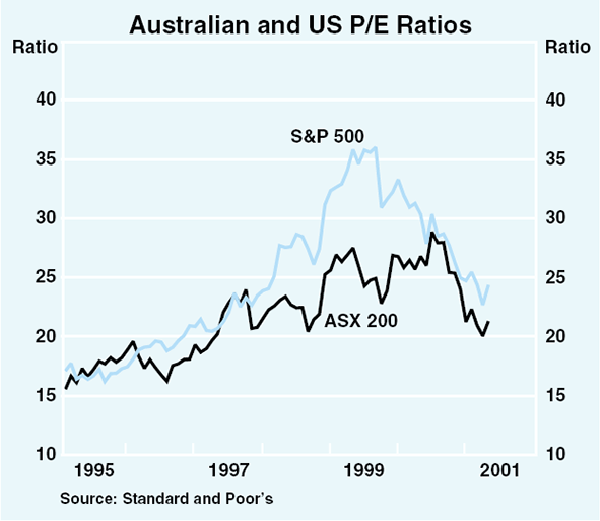
Margin lending by banks and brokers for the purchase of shares grew by 9 per cent in the six months to March, down from over 20 per cent in the same period last year. The number of clients with margin loans rose slightly, but total borrowing limits were scaled back by almost 20 per cent. The average leverage ratio (ratio of loans to value of shares or managed funds held as collateral) has changed little over the past year at around 50 per cent and remains well below the maximum rate of 70 per cent that lenders say they will make available for ‘blue chip’ shares. The number of clients receiving a margin call increased during the March quarter, reflecting the volatility in share prices seen in recent months, but remains at a low level.
So far this year, the corporate sector has raised $608 million through initial public offerings, around half the amount raised in the same period last year. The volatility of the share market and the poor performance of a number of recent initial public offerings have meant that several proposed floats have now been either cancelled or postponed.
Assessment of Financial Conditions
As noted in the chapter on ‘Domestic Financial Markets’, monetary policy has been eased during 2001 in response to the changing balance of risks to the outlook for growth and inflation. Taken together with other indicators, this suggests that financial conditions are relatively expansionary at present. Interest rates are below average and near previous cyclical lows. The yield curve has returned to having its customary upward slope. Credit growth remains moderate to strong, and the exchange rate is low compared with historical experience.
Interest rates
The cash rate has been reduced by 1¼ percentage points since the beginning of the year to 5 per cent (Graph 55). This reduction has been less than the reduction in US rates, but more than in other English-speaking countries (see the chapter on ‘International Financial and Foreign Exchange Markets’). The reduction in the cash rate also has been more rapid this easing cycle than in 1996–97 when the first three reductions in rates were spread over six months. The favourable outlook for inflation has permitted the stance of monetary policy to shift quickly to one that is supportive of domestic economic activity.

Much commentary focuses on changes in interest rates, but in any assessment of the effect monetary policy is likely to be exerting on the economy, it is more important to focus on the level of interest rates. In so doing, some notion of whether the level of rates is high or low relative to a benchmark is required. For practical purposes, the Bank has tended to regard the average level of interest rates over the period in which inflation has been low – since 1992 – as a rough benchmark. Over that period the economy has recorded good growth on average and inflation has not had a noticeable trend in either direction.
On this measure, it is reasonably clear that the stance of monetary policy is expansionary as a result of the declines in interest rates in 2001. Measures of both the nominal and real cash rate are below their respective average levels of recent years, and are close to the two previous cyclical lows. Rates charged by financial intermediaries are now noticeably lower in real terms than the average over the past decade, reflecting the reduction in the real cash rate and the compression in interest margins over recent years.
These measures of real interest rates are only approximations, in that actual past inflation is used as a proxy for expectations of future inflation, which are not easily observable. (See Box B of the February 2001 Statement on Monetary Policy for a discussion of real interest rates.) In using them, account must therefore be taken of the possibility that inflation expectations and actual inflation may not be related in the same way as in the past. It is quite possible, for example, that inflation expectations are lower and better anchored now than was the case in the past, given that average inflation has been low for a number of years now. In this case, the true level of real interest rates might be slightly higher than estimated.
The difference between long rates – set by the market – and short-term rates, which are dominated by the central bank's policy actions, can provide another gauge of the stance of policy. Over recent months, rates further out along the yield curve have returned to being above those at the short end, as short rates have fallen and long rates have risen. Long-term rates are now around 100 basis points higher than short-term rates, which is a more common relationship than the inverted yield curve which prevailed late in 2000 (Graph 56). This appears to reflect a collective view among market participants that the uncertainties surrounding the economic outlook are starting to abate. This is, of course, an indication of current market views, and could change as new information becomes available. Nonetheless, it does suggest that policy settings are expansionary, though perhaps slightly less so than in 1999.
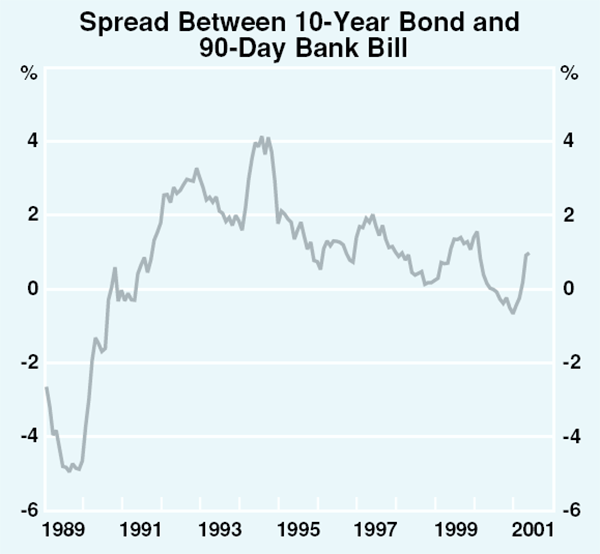
Financial aggregates
Growth in the monetary aggregates accelerated in the March quarter after weakening in the latter half of 2000, with the wider aggregates, M3 and broad money, growing at the fastest quarterly pace for some time. Prominent in the pick-up in growth of intermediaries' domestic deposit liabilities have been certificates of deposit, issuance of which has probably been encouraged by the significant fall in short-term interest rates. Among funding sources not counted in the monetary aggregates, domestic bond issuance remained solid in the face of moderately lower bond yields, and borrowing from foreigners continued at a strong pace.
At an annualised rate of 9 per cent in the six months to March, credit growth has eased a little along with the decline in growth in the economy, but remains within the range experienced for most of the 1990s expansion (Graph 57). Measured on a shorter-term basis, credit growth in fact picked up a little in the March quarter, underpinned by stronger business borrowing, in part reflecting borrowing to fund tax payments. Households continue to borrow at a faster pace than businesses, although the composition of household borrowing has shifted, with a slowdown in the pace of personal lending offsetting continued strong borrowing for housing. Overall, the pace of growth of money and credit can be described as moderate to strong. Lack of access to credit is unlikely to be constraining investment or consumption decisions.
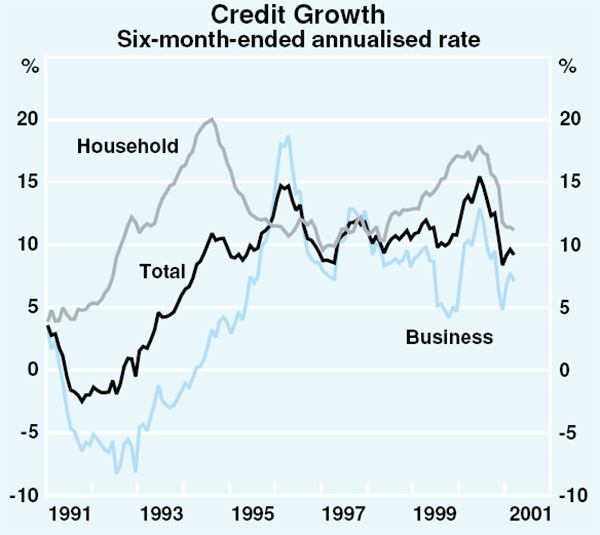
Real exchange rate
As discussed in the chapter on ‘International and Foreign Exchange Markets’, the Australian dollar has risen in recent weeks, although it remains quite low both against the US dollar and on a trade-weighted basis. An assessment of the influence on the economy of the depreciation can be gauged by measures of the real exchange rate, which adjust for differences in inflation rates across countries. Given that inflation in Australia and most major trading partners has remained comparably low in recent years, however, the nominal depreciation over the past year has translated into a real depreciation of around the same magnitude.
Graph 58 shows that on a trade-weighted inflation-adjusted basis, the real exchange rate has fallen by 8½ per cent over the year to the March quarter, to be 13½ per cent below its 1990s average and around historically low levels. Alternative measures of the real exchange rate, such as those compiled by the IMF and the OECD, also show a marked depreciation over the recent period.
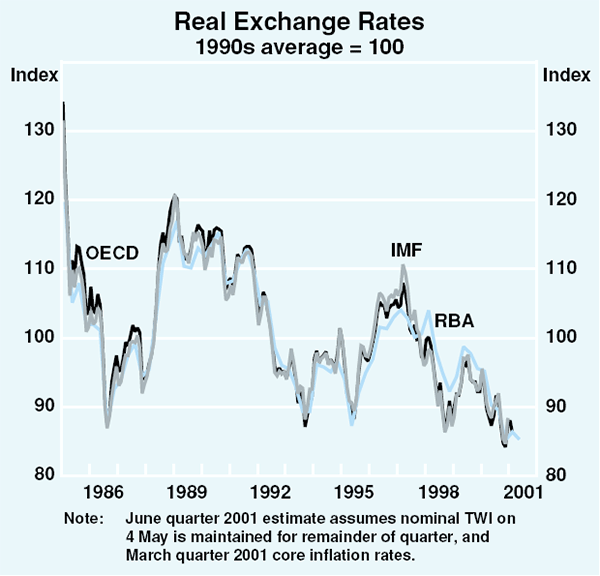
Assessing the significance of the exchange rate for the purposes of monetary policy is complicated by the problem that some exchange rate changes occur in response to shifts in the ‘real’ trade fundamentals facing the economy. However, there seems little doubt that the current level of the real exchange rate confers on Australian exporting and import-competing companies a significant price advantage over comparable foreign firms. These conditions are supportive of continued strong growth in the traded sector of the economy.
Inflation Trends and Prospects
Recent developments in inflation
Consumer prices
The Consumer Price Index increased by 1.1 per cent in the March quarter 2001 and by 6.0 per cent over the year (Graph 59, Table 11). The rise in the quarter was broadly based, although it was boosted by some factors which are likely to prove temporary. The recent tax changes continue to affect CPI inflation and the various measures of underlying inflation in year-ended terms. Despite falling in the March quarter, the rise in petrol prices over the past year is still boosting the year-ended CPI inflation rate. Making an allowance for these effects, underlying inflation is estimated to be about 2½ per cent, a little higher than it was estimated to be in December. This is consistent with some pass-through of the upstream price increases over the past year to the retail level. This assessment continues to be subject to a significant degree of uncertainty, reflecting the difficulty in estimating the size and timing of the tax effects.
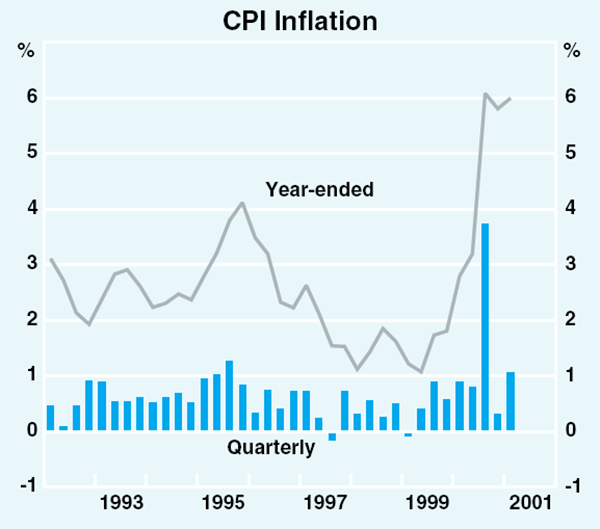
| Quarterly | Year-ended | ||||
|---|---|---|---|---|---|
| Dec quarter 2000 |
Mar quarter 2001 |
Dec quarter 2000 |
Mar quarter 2001 |
||
| CPI | 0.3 | 1.1 | 5.8 | 6.0 | |
| – Tradeables | 0.2 | 1.4 | 3.8 | 4.8 | |
| – Non-tradeables | 0.5 | 0.7 | 7.6 | 7.1 | |
| CPI excluding volatile items | 0.2 | 1.0 | 5.1 | 5.5 | |
| Market goods and services excluding volatile items |
0.3 | 0.8 | 5.2 | 5.5 | |
| Weighted median(a) | 0.4 | 0.9 | 5.2 | 5.4 | |
| Trimmed mean(a) | 0.4 | 0.9 | 5.8 | 6.0 | |
| (a) For details on the calculation of these measures, see ‘Measuring Underlying Inflation’, RBA Bulletin, August 1994. This is available on the Bank's website: <www.rba.gov.au.> | |||||
As noted in the February Statement, the lower than expected outcomes for the CPI in the September and December quarters were open to three possible interpretations. One was that the timing of the net effects of the introduction of the GST and the abolition of Wholesale Sales Tax was different from what had been expected, with a smaller initial upward price impact followed by lesser downward price effects in subsequent quarters, perhaps because the falls in WST had been passed on more quickly than assumed. Alternatively, it was possible that the long-run price level increase associated with tax reform had simply been overestimated. The final possible explanation was that the net tax effects were broadly as expected, but that the underlying rate of inflation net of taxes had unexpectedly fallen – though whether this was temporary or persistent was unclear. Of course, these explanations are not mutually exclusive: it was possible that they were all true to some extent. With the benefit of the March quarter reading, it appears that businesses were initially slow to pass on some of the tax effects and various other cost pressures which were experienced during 2000, temporarily accepting a reduction in profit margins. This resulted in the lower-than-expected September and December quarter readings for CPI and underlying inflation. In the most recent quarter, it appears that more of these cost pressures have begun to be passed on, with the result that some of the price rises which were expected to occur last year have now shown up.
The largest contribution to the rise in the CPI in the March quarter was a 3.1 per cent increase in food prices. This largely reflected the effects of flooding in northern New South Wales and southern Queensland, which caused severe shortages of fruit and vegetables that should prove temporary. The price of meat products also rose sharply in line with the increase in world prices following the outbreak of foot-and-mouth disease in a number of countries. Other major contributors to the increase in the CPI in the March quarter were higher alcohol and tobacco prices, which were underpinned by the increase in excise on these items in February and an unwinding of discounting in the December quarter, as well as seasonal increases in the prices of education, childcare and pharmaceuticals (reflecting the operation of the Pharmaceutical Benefits Scheme). Partly offsetting these increases were falls in the prices of clothing, a result of the difficult trading environment in this sector, and domestic holiday travel and accommodation, reflecting discounted airfares.
The fall in petrol prices and the slower growth in the cost of house purchase also moderated the rise in the CPI in the March quarter. Petrol prices fell by 3.7 per cent in the March quarter – the first fall recorded in two years – although they remained over 11 per cent higher than a year earlier. Petrol prices rebounded during the March quarter, and if oil prices and the exchange rate remain around current levels, are likely to boost the CPI in the June quarter. The house purchase component of the CPI rose by 14 per cent over the year to the September quarter 2000 (including tax effects) but increased by just 0.2 per cent in each of the following two quarters, reflecting the subdued state of the housing sector. The additional $7,000 grant to first-home builders introduced in March lessened the increase in this component in the March quarter CPI and will have a similar effect in the June quarter.
Throughout 2000, the effect of the falling exchange rate appeared to be absorbed into retailers' margins, with subdued tradeables prices recorded in the CPI despite strong increases in import prices ‘at the docks’. This probably reflected some combination of competitive pressures, businesses' concerns about weakening domestic demand and a desire to avoid changing retail prices in response to falls in the exchange rate that many firms expected to be short-lived. In the March quarter, businesses appeared to pass some of the higher import prices through to the consumer. In aggregate, the prices of tradeable goods and services, excluding petrol, rose by 2 per cent in the quarter, although a significant part of the rise reflected higher prices for a range of food items. The price of imported motor vehicles rose by 2.7 per cent in the March quarter, the largest rise in this component in three years. The prices of other items with a high import content, such as appliances, toys and audio, visual and computing equipment, also rose. While the magnitude of many of these price rises was relatively small, the prices of these goods have been flat or on a downward trend in recent years. For example, the price of audio, visual and computing equipment has fallen by over 35 per cent over the past five years but rose by around 0.6 per cent over the past two quarters.
Producer prices
Upstream price pressures, which had been building over the course of 2000, abated in the March quarter (Table 12). Producer prices generally fell in the quarter, a result of lower world oil prices (with Asian-benchmarked oil prices falling by almost 14 per cent in the quarter), a slight rise in the exchange rate and softer world prices for some products. The effect of the fall in oil prices, and a more substantial decline in the price of diesel, is evident at all stages of production (Graph 60). Larger declines were recorded in prices at earlier stages of production in the March quarter, as the impact of commodity price movements on final-stage prices is diluted by the contribution of labour costs, overheads and profit margins. Excluding the movements in fuel prices, producer prices fell only modestly at earlier stages of production and, apart from import prices, recorded increases at the final stage.
| Mar quarter 2001 |
Year to Mar quarter 2001 |
|
|---|---|---|
| Preliminary | −2.6 | 6.0 |
| Domestic | −1.9 | 4.9 |
| Imported | −6.8 | 13.1 |
| Intermediate | −1.6 | 5.3 |
| Domestic | −1.0 | 4.3 |
| Imported | −5.3 | 11.8 |
| Final(a) | ||
| Domestic | 0.1 | 2.5 |
| – Consumption | 0.1 | 2.7 |
| – Capital | 0.2 | 2.5 |
| Imported | −1.3 | 9.5 |
| – Consumption | −1.4 | 9.7 |
| – Capital | −1.2 | 9.3 |
| Total | −0.1 | 3.8 |
| – Consumption | −0.2 | 4.0 |
| – Capital | −0.1 | 3.6 |
| (a) Excluding exports | ||
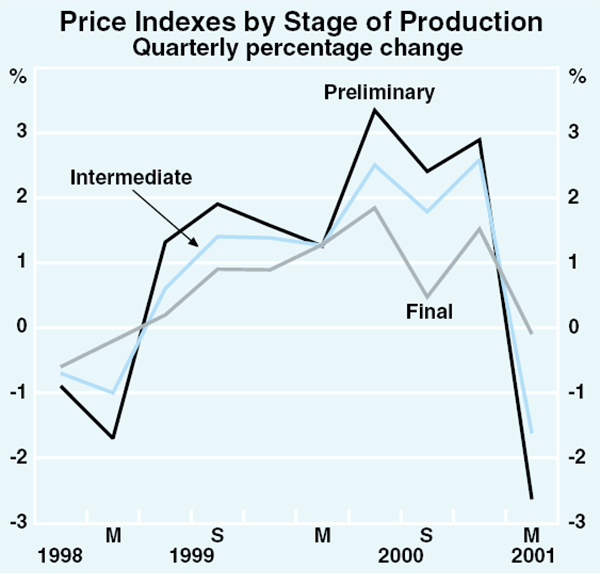
The final-stage index of consumer products has increased by 4.0 per cent over the year. While this index most closely parallels the composition of the CPI, it places a much higher weight on goods and is measured at basic prices rather than retail prices (that is, prior to the imposition of indirect taxes, transport costs and trade margins).
Sharp rises in the prices of raw materials over the past year have driven rapid price rises at early stages of production. These movements were partly reversed in the March quarter. Within the manufacturing sector, the prices of inputs fell by 2.7 per cent in the quarter, largely due to lower oil prices and falling prices for base metals, both of which had risen strongly over the previous year. In the services sector, higher prices for road transport, together with higher real estate agents' fees, were partly offset by seasonal declines in the prices of business services related to television advertising. In the construction sector, the prices of building materials used in housing declined further in the March quarter, reflecting the downturn in residential construction, but increased at a modest pace for non-residential construction materials.
Overall, while upward pressure on domestic prices from prior increases in raw materials prices remains, there are indications that these pressures may have eased. This is supported by the major business surveys, which report that while product prices have increased quite strongly over the past year, they are likely to increase more slowly in the period ahead (Graph 61). The ACCI-Westpac survey of manufacturers indicates sharply lower expectations for product price rises in the June quarter and reduced inflationary pressures from input costs. The economy-wide NAB survey suggests that the rate at which firms expect to increase product prices has declined, as have expectations for input price inflation; firms expect that both will increase by around ½ a per cent in the June quarter.

Labour costs
Most measures of wages growth increased a little during the second half of 2000 (Table 13, Graph 62). The wage cost index (WCI) rose by 3.4 per cent over the year to December 2000, up from a little under 3 per cent in mid 2000, with both the private-and public-sector components recording an increase. Average weekly ordinary-time earnings (AWOTE) increased by 5.1 per cent over the course of 2000, up from 4.3 per cent over the year to mid 2000. However, compositional effects, which seem likely to have overstated the underlying pace of wages growth in the recent period, continue to cloud the interpretation of the AWOTE data. The Mercer Cullen Egan Dell (MCED) Salary Review reported that executive base salaries increased by a little under 5 per cent over the year to the March quarter 2001, up from around 4½ per cent over the year to June 2000. In contrast to most of the other measures, however, a measure of non-executive pay that can be derived from the MCED data indicates that wages growth has been relatively steady, at just over 4 per cent over the year to March 2001.
| Dec 1999 |
Jun 2000 |
Dec 2000 |
|
|---|---|---|---|
| Wage cost index(a) | |||
| Private | 2.8 | 2.9 | 3.5 |
| Public | 3.5 | 2.7 | 3.1 |
| Total | 3.0 | 2.8 | 3.4 |
| Average weekly earnings survey | |||
| AWOTE | 3.0 | 4.3 | 5.1 |
| AWE | 1.6 | 3.9 | 5.1 |
| Executive remuneration | |||
| Base salaries | 4.6 | 4.5 | 4.8 |
| New federal enterprise agreements(b) | |||
| Private | 3.5 | 3.8 | 4.1 |
| Public | 3.1 | 3.0 | 3.8 |
| Total | 3.4 | 3.4 | 3.9 |
|
(a) Total pay excluding bonuses Sources: ABS, DEWRSB, Mercer Cullen Egan Dell |
|||
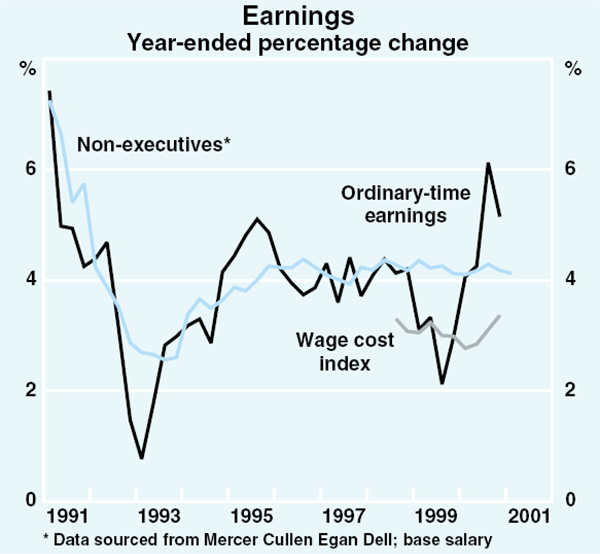
Wage increases provided by new federal enterprise agreements picked up to an average annualised rate of 3.9 per cent in the December quarter 2000, from 3.4 per cent six months earlier. The wage increase for private-sector agreements rose to 4.1 per cent, up slightly from the observation for the September quarter, partly reflecting the effect of ‘Campaign 2000’ in the Victorian manufacturing sector; wage increases in the metals manufacturing sector increased by half a percentage point in the December quarter, to 4.6 per cent. In the construction industry, federal enterprise agreements certified in the December quarter provided an average wage increase of 4.9 per cent, in line with the agreements reached earlier in 2000. The average wage increase in public-sector agreements rose more sharply in the second half of 2000, but this was affected by distortions arising from renegotiation lags in a couple of large agreements, and the level of wage increases is moderate. Wage increases provided by the stock of all currently active federal agreements edged up slightly from 3.6 per cent in the middle of 2000 to 3.7 per cent in the December quarter.
Lower-than-expected CPI outcomes following the implementation of the tax changes in mid 2000 have reduced the likelihood of additional wage increases being generated by the GST-related clauses incorporated in some enterprise agreements, despite the prevalence of these clauses having risen over the course of 2000. Business surveys also point to reduced pressure on wages in the near term. The NAB survey indicates that there has been a further reduction in the number of firms reporting the lack of availability of suitable labour as a constraint on output. The latest ACCI-Westpac survey of manufacturers continues to suggest that labour constraints are relatively modest compared with the levels of late 1999 and early 2000, despite picking up slightly in the March quarter 2001.
In its Safety Net Review decision, announced on 2 May, the Australian Industrial Relations Commission granted a three-tier increase to award wages ranging from $13 to $17 per week depending on the award rate. This represents a similar increase, on average, to that which was granted last year. The federal minimum wage was increased by 3.2 per cent to $413.40 per week.
Inflation expectations
The inflation expectations of consumers have declined considerably following the introduction of the tax changes in mid 2000, and are now around the levels prevailing in 1998 (Graph 63). According to the Melbourne Institute, the median expectation for inflation over the coming year has fallen from a peak of over 8 per cent in May 2000 to be around 4 per cent over the past few months. Recent volatility in this series largely reflects the distribution of responses – a small increase in the number of respondents expecting higher rates of inflation can easily move the median from 3½ to 4½ per cent.
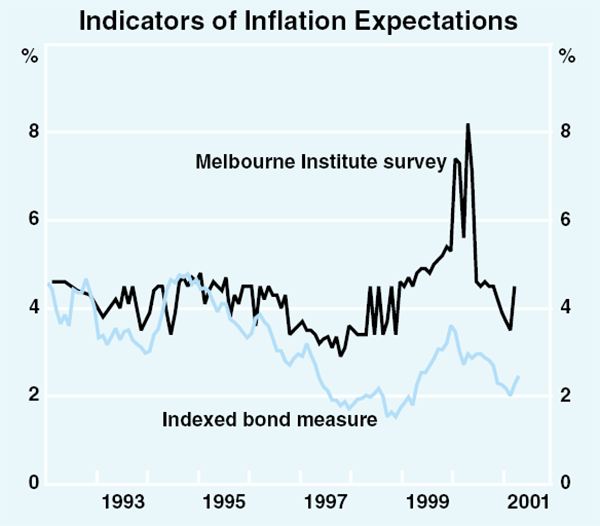
Financial-market economists surveyed by the Bank revised up their inflation forecasts for the year to June 2001 following the higher-than-expected March quarter CPI outcome, but inflation forecasts for the year to June 2002 edged down slightly (Table 14). The median inflation forecast for the year to June 2001 is 5.7 per cent and 2.7 per cent excluding tax effects, while the median forecast for the year to June 2002 is 1.9 per cent and 2 per cent excluding tax effects. The median estimate of the tax effects on inflation over the year to June 2001 has been revised up slightly to 3 per cent, and most respondents continue to expect tax changes to have little effect on inflation over the following year. Most respondents expect a moderate appreciation in the exchange rate and falls in oil prices over the forecast horizon. Trade union officials, as surveyed by the Australian Centre for Industrial Relations Research and Training (ACIRRT), have increased their forecasts for inflation for 2001 and 2002, after decreasing them in the previous survey. In the most recent survey, union officials have returned to their view that inflation will remain high in 2002, despite the tax effects dropping out of the annual inflation figure.
| Year to June 2001 | Year to June 2002 | ||||||
|---|---|---|---|---|---|---|---|
| November 2000 |
February 2001 |
May 2001 |
November 2000 |
February 2001 |
May 2001 |
||
| Market economists(a) | |||||||
| CPI | 5.4 | 5.0 | 5.7 | 2.4 | 2.0 | 1.9 | |
| – Excluding GST | 2.8 | 2.3 | 2.7 | 2.4 | 2.1 | 2.0 | |
| Union officials(b) | |||||||
| ‘Inflation’ | 6.0 | 4.5 | 5.5 | 4.5 | 3.5 | 4.5 | |
| (a) RBA survey (b) ACIRRT survey |
|||||||
Longer-term inflation expectations of financial market participants, measured by the difference between nominal and indexed 10-year bond yields, have risen slightly over the past three months. A rise in nominal yields, in line with developments in global bond markets, implies that long-term inflation expectations are currently around 2½ per cent, about a quarter of a percentage point above implied expectations in February, but down from around 3¾ per cent in early 2000.
Medium-term inflation expectations of businesses have fallen in the March quarter, largely reversing their rise over the past year. The March quarter NAB survey reports that the proportion of respondents expecting inflation to average more than 4 per cent has fallen to less than 10 per cent, while just over one-third expect inflation to average less than 3 per cent. These proportions are similar to expectations prevailing 12 to 18 months ago.
Inflation outlook
The latest CPI increase was above most expectations, in contrast to the two preceding observations, which were lower than expected. Abstracting from estimated tax effects, the various underlying measures of inflation in the March quarter give a range of readings which centre on 2½ per cent, up from the estimate of ‘around 2 per cent’ in December which the Bank offered in the February Statement.
The uncertainties in disentangling tax effects from underlying price movements since mid 2000 were outlined above. With the benefit of an additional CPI reading, it appears that the most plausible explanation is that businesses may have initially absorbed some of the effects of tax changes, exchange rate depreciation and other cost imposts in their margins, thus holding price increases below what would have been expected. Subsequently, it appears that businesses may have begun to rebuild margins, passing on some of the cost increases. Abstracting from this temporary margin squeeze, on balance, it appears that underlying inflation has changed little since the middle of 2000, after having increased noticeably over the preceding year.
This process of margin rebuilding probably has some way to go, given how far the exchange rate has fallen and the extent of various ‘upstream’ price pressures during 2000. Hence, it seems unlikely that inflation will fall noticeably in the short term. But equally, inflation is unlikely to increase in a way that would seriously threaten the inflation target, as the current period of weak growth in aggregate demand should help limit the degree to which businesses will be able to raise prices.
In addition, the pace of increase in producer prices has diminished. If this continues, the pressure on consumer prices from ‘upstream’ cost increases will, in time, also abate. Labour costs have picked up more quickly in the past couple of quarters, and this trend might well continue for a time. But wages growth remains moderate at present, and labour market conditions have softened in the past six months which should cap any tendency for acceleration in wages in due course. It is also helpful that inflation expectations of consumers have remained relatively steady in recent months and so are unlikely to fuel any increase in wage demands in the period ahead, and that there is little evidence of any wage rises initiated by the GST per se.
Hence the Bank's forecast is that underlying inflation, net of taxes, will remain around its current rate of 2½ per cent over the coming year. Measured by the Consumer Price Index – which is the inflation measure relevant for the inflation target over the medium term – inflation on a year-ended basis will remain high until the June quarter 2001 as a result of the effects of tax reforms. It could thereafter fall slightly below underlying measures of inflation as some additional indirect taxes are removed. Over a somewhat longer horizon, as the rate of increase in costs diminishes as a result of the current period of weak demand growth, inflation on both measures might fall slightly. This forecast is based on the standard technical assumption that the exchange rate remains around recent levels and that the price of oil remains around US$27 per barrel.
General risks to the inflation outlook can be seen in both directions. The upstream pressures associated with the lower exchange rate might flow through faster than currently envisaged and boost inflation in the year ahead. This would be more likely if the economy returns to strong growth relatively quickly, though in that case the exchange rate might well appreciate. The main downside risk is that the global (and therefore domestic) outlook for economic activity could weaken further. If it occurred, this would be expected to exert some disinflationary pressure into 2002.
Footnote Box A
A business is generally regarded as small if it is independently owned and operated, and is closely controlled by owners/managers who contribute most, if not all, the operating capital. For statistical purposes, the Australian Bureau of Statistics (ABS) defines a small business as one that employs less than 20 people. It defines medium businesses as those employing between 20 and 200 people, while large businesses are those that employ 200 or more people. The ABS excludes public companies, businesses that are in a parent or subsidiary relationship and cooperatives and associations from its definition of small business. Most of the data used in this Box are from the ABS survey, Small Business in Australia, ABS Cat No 1321.0. [1]